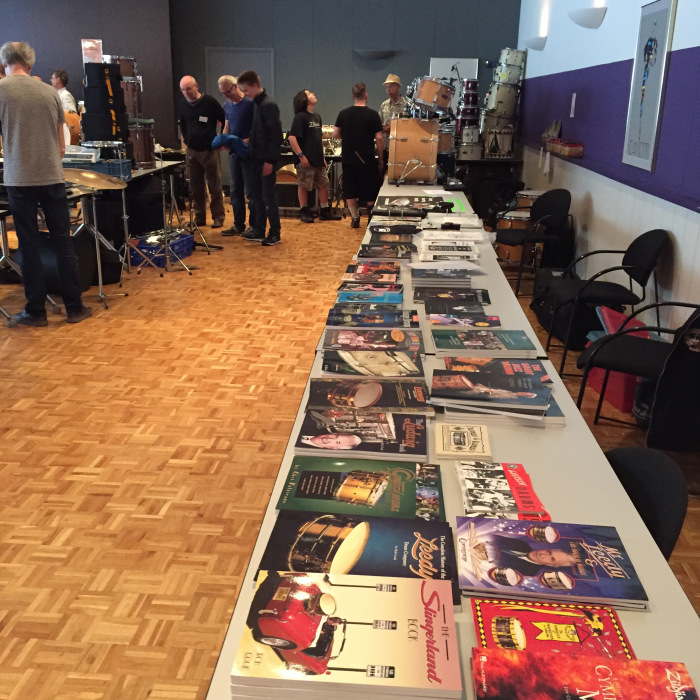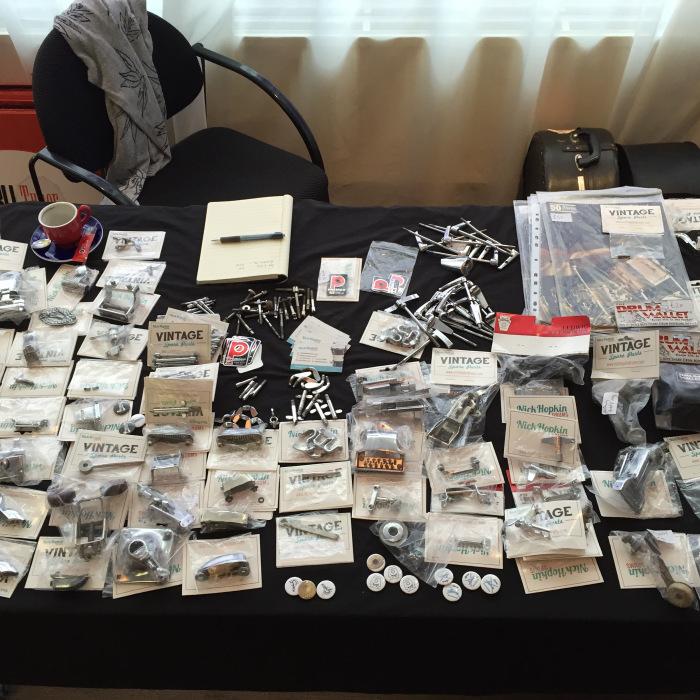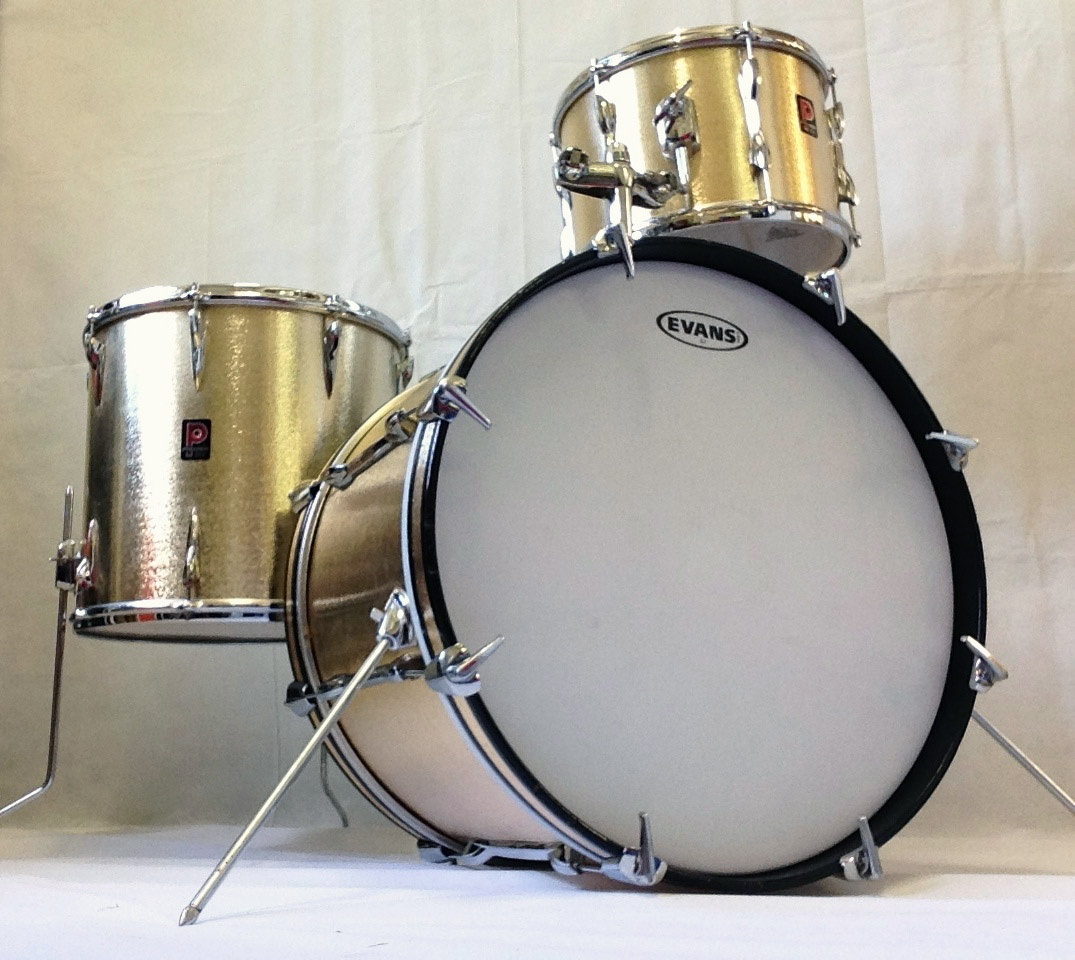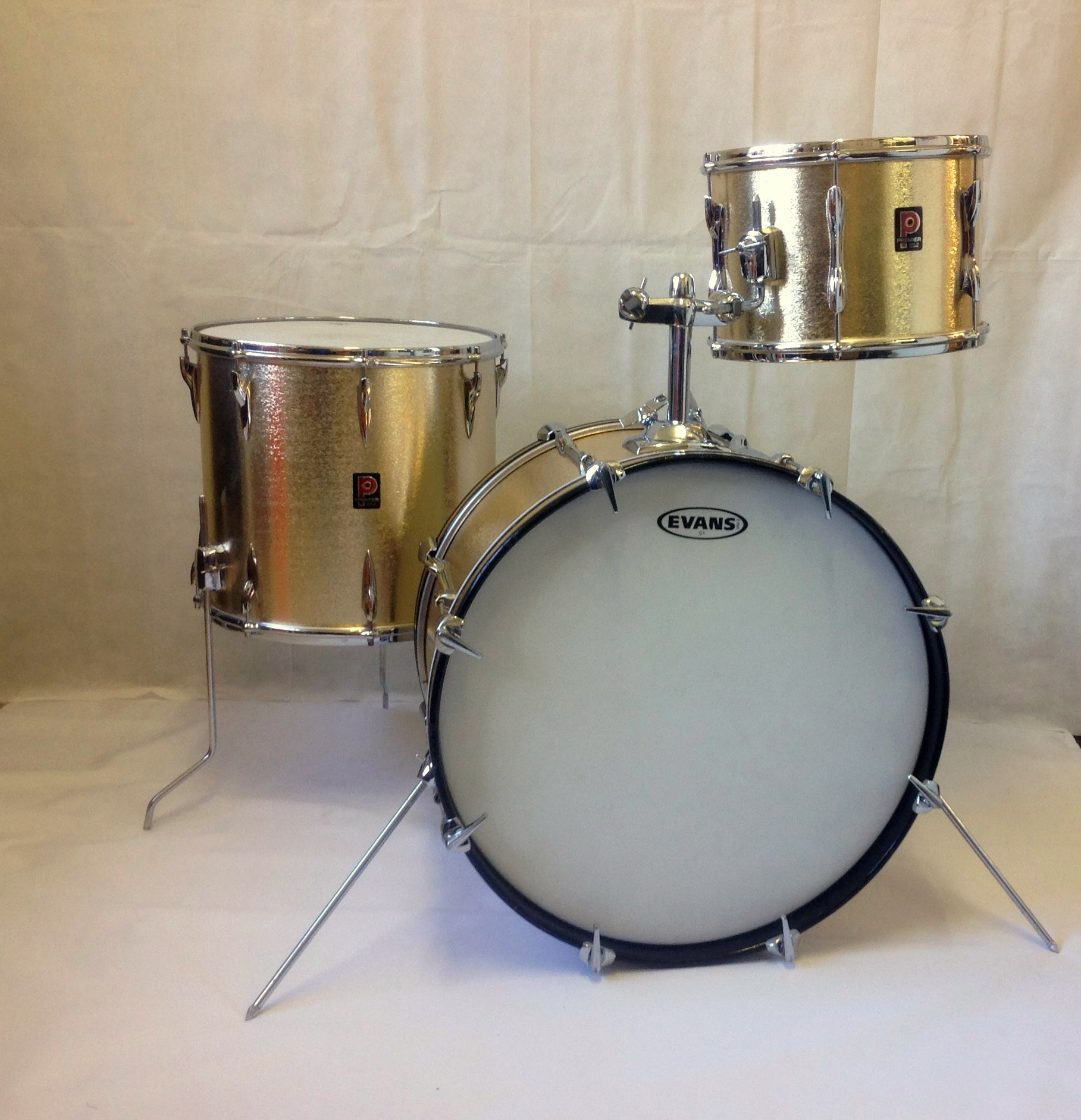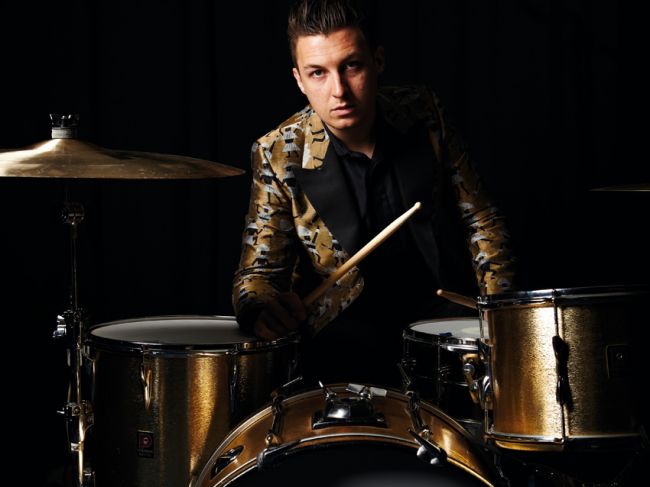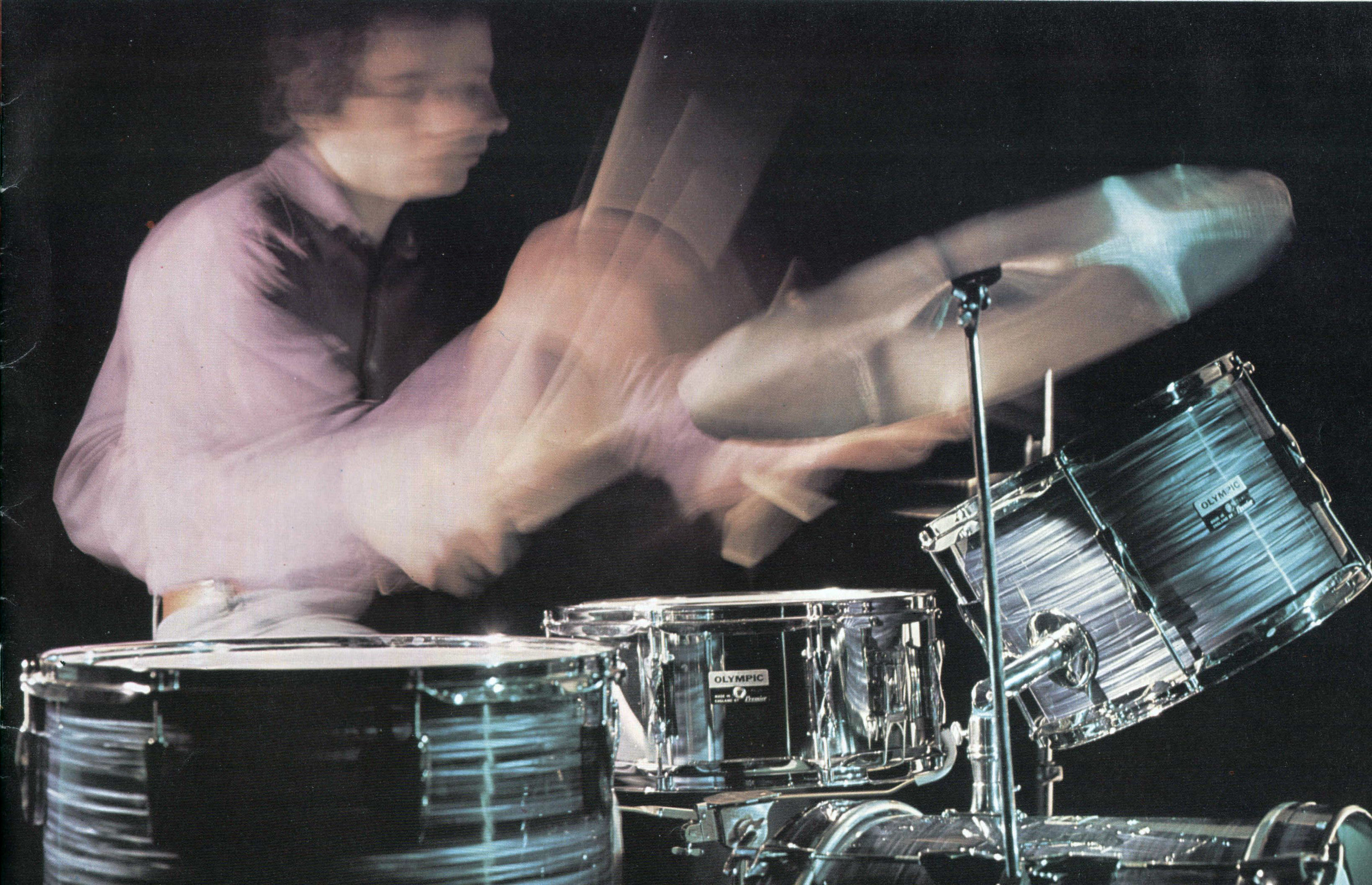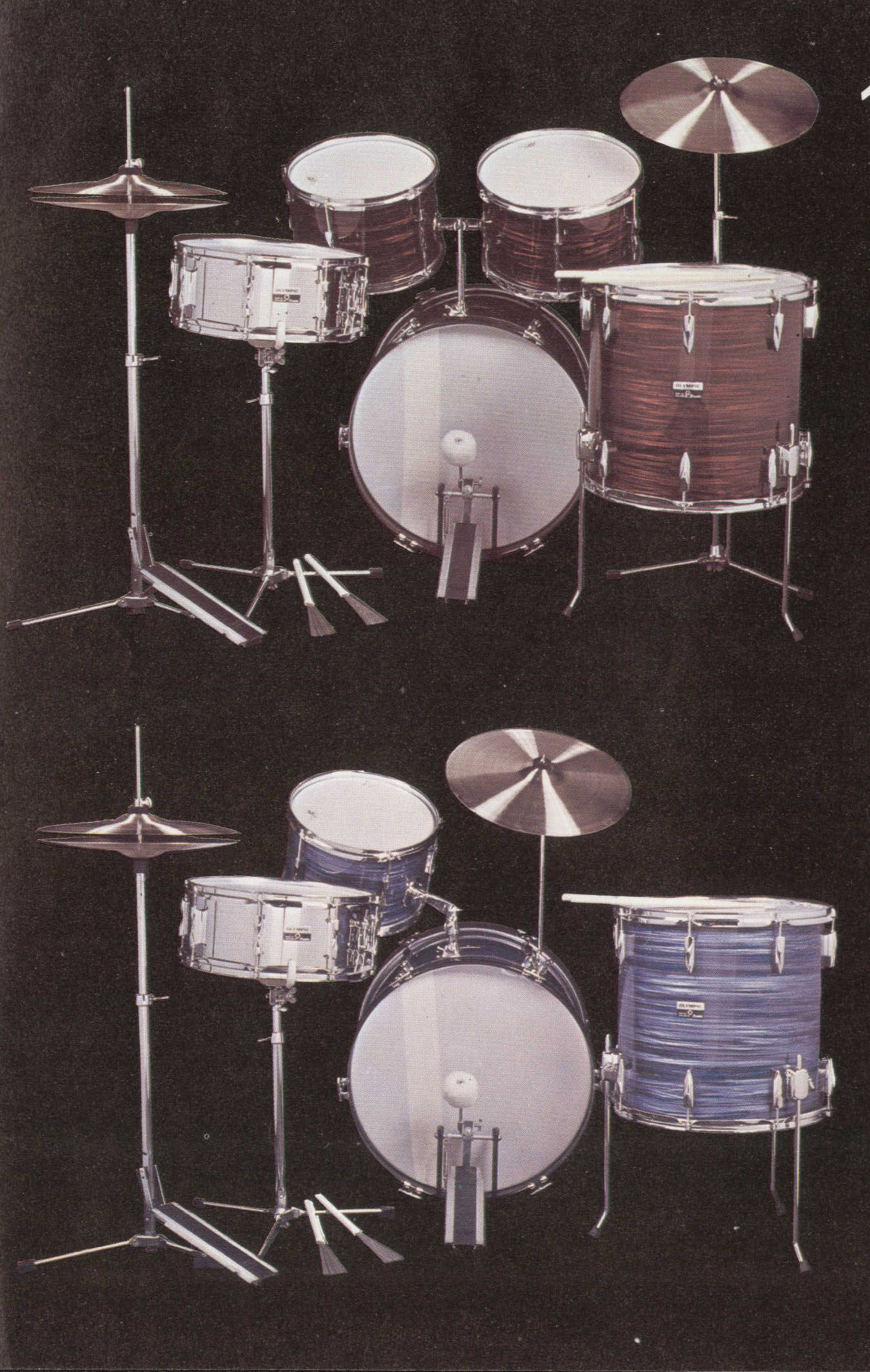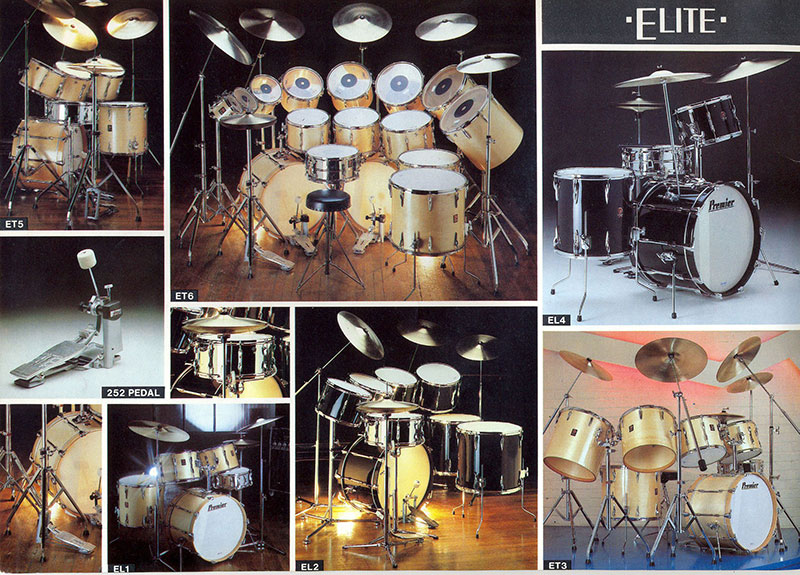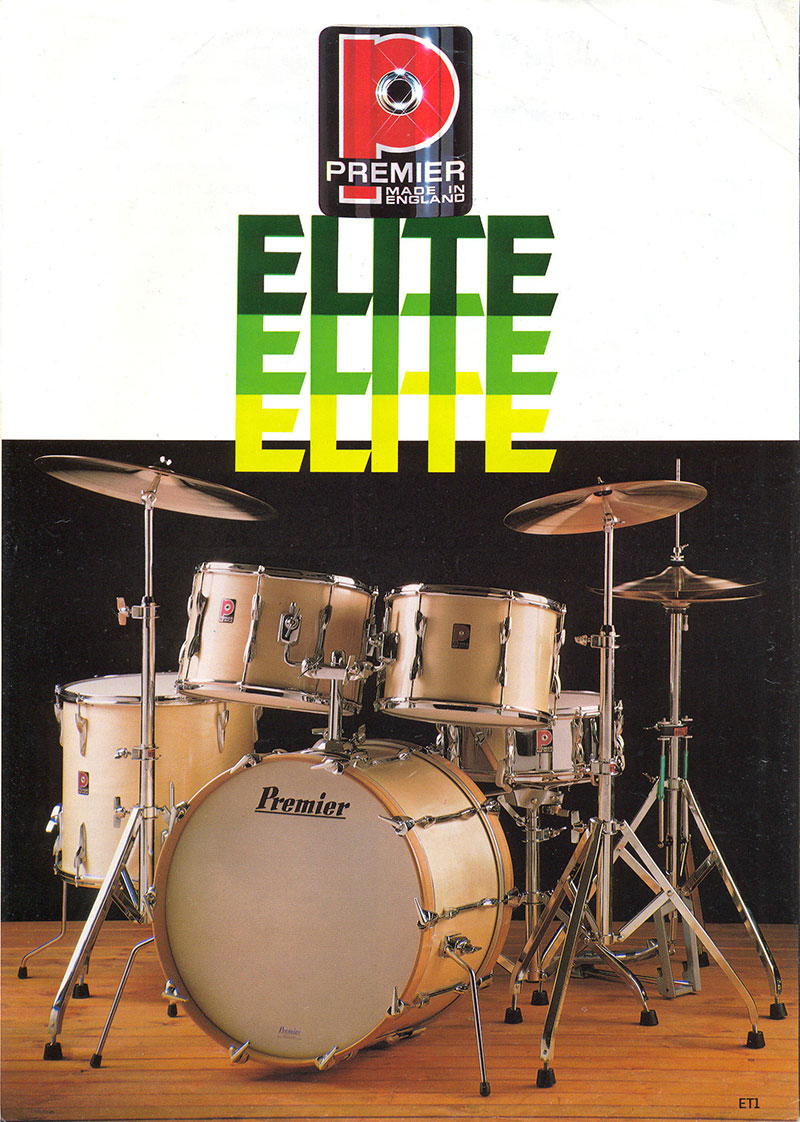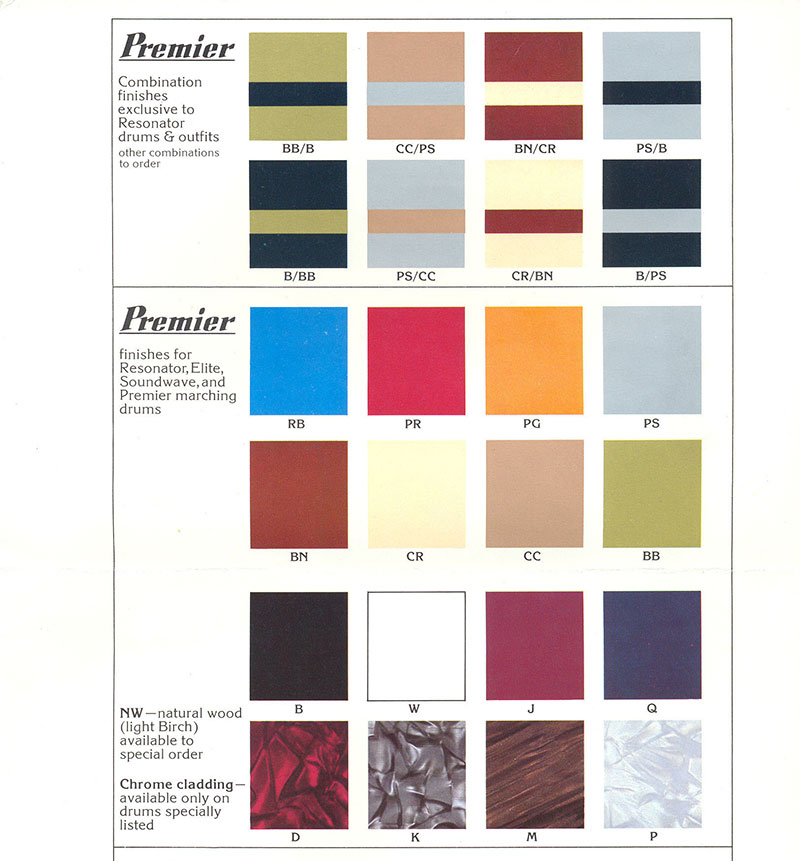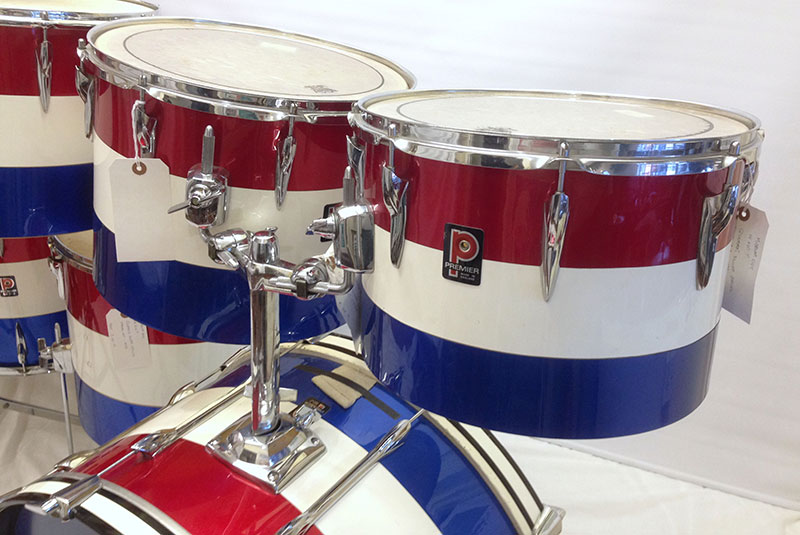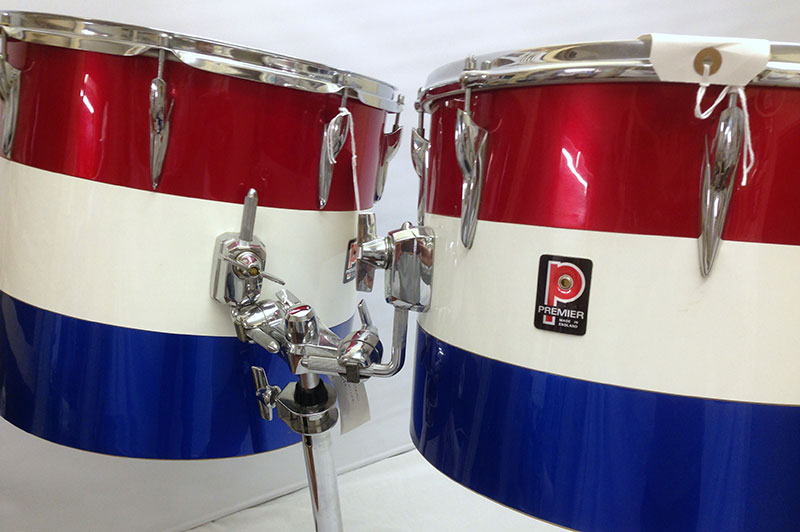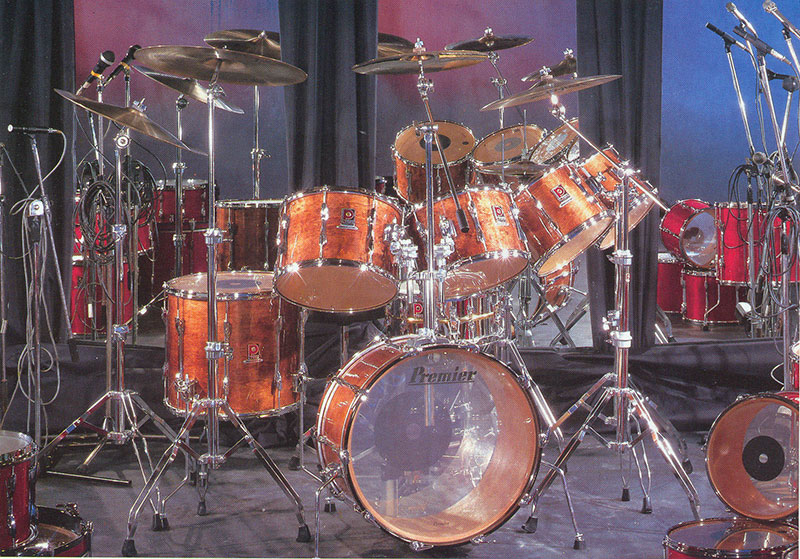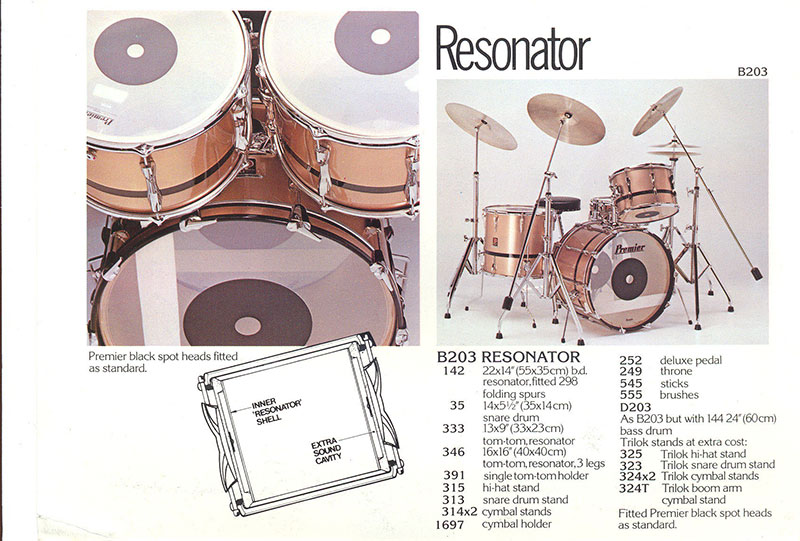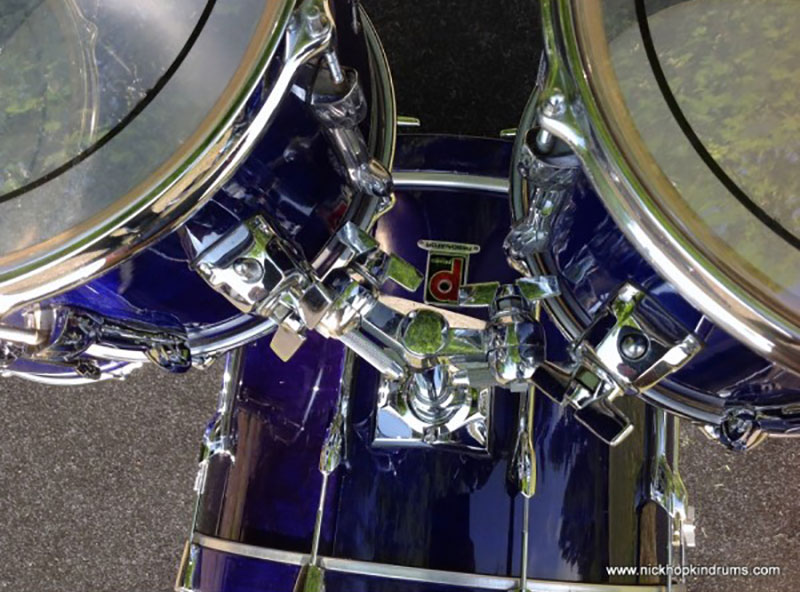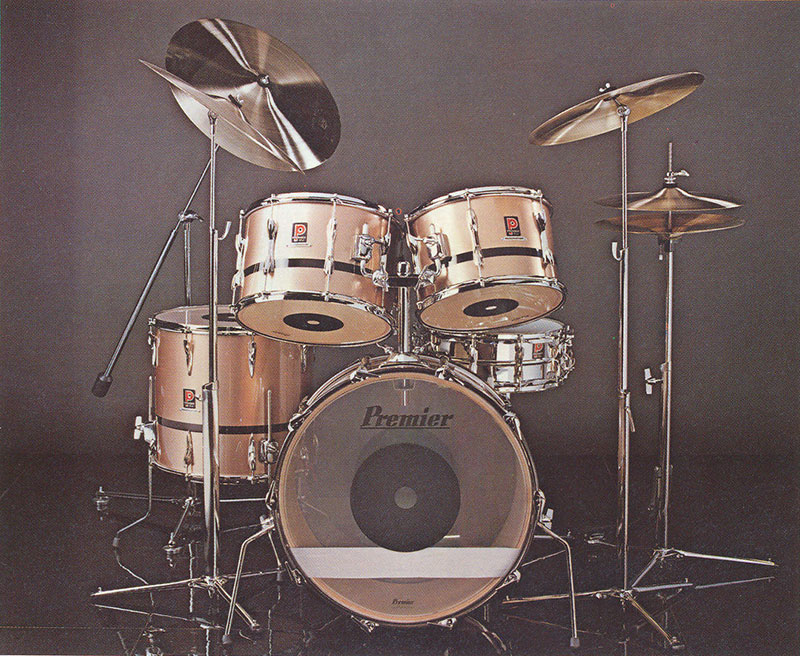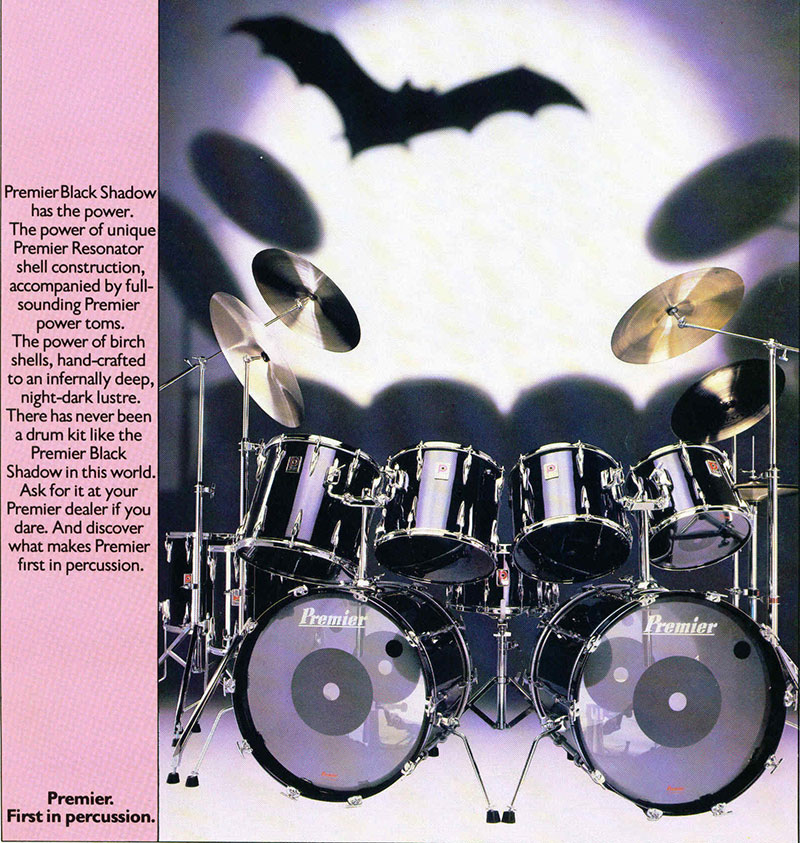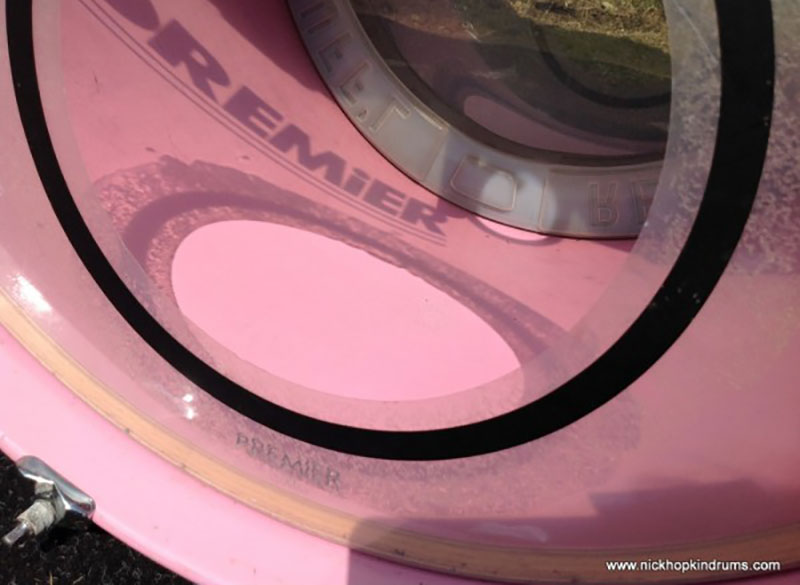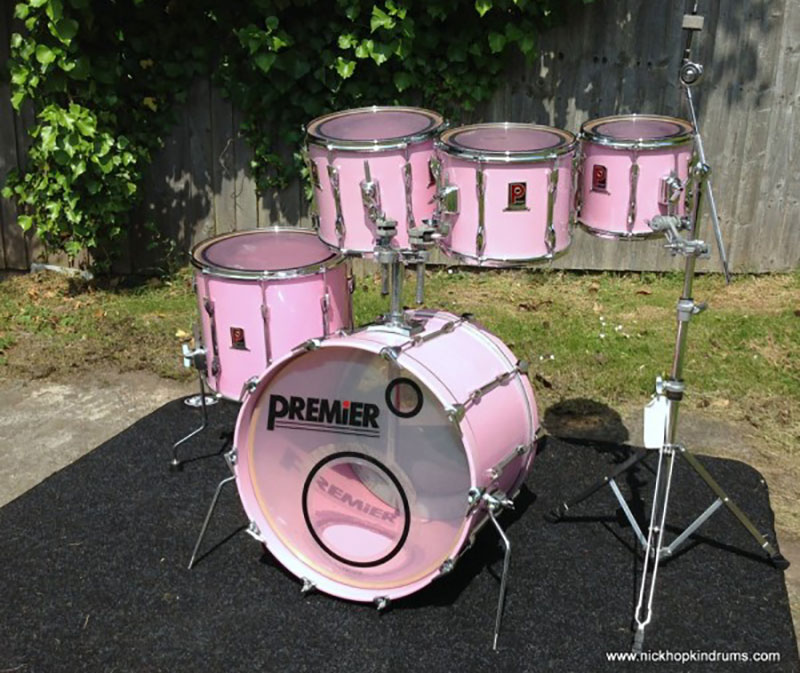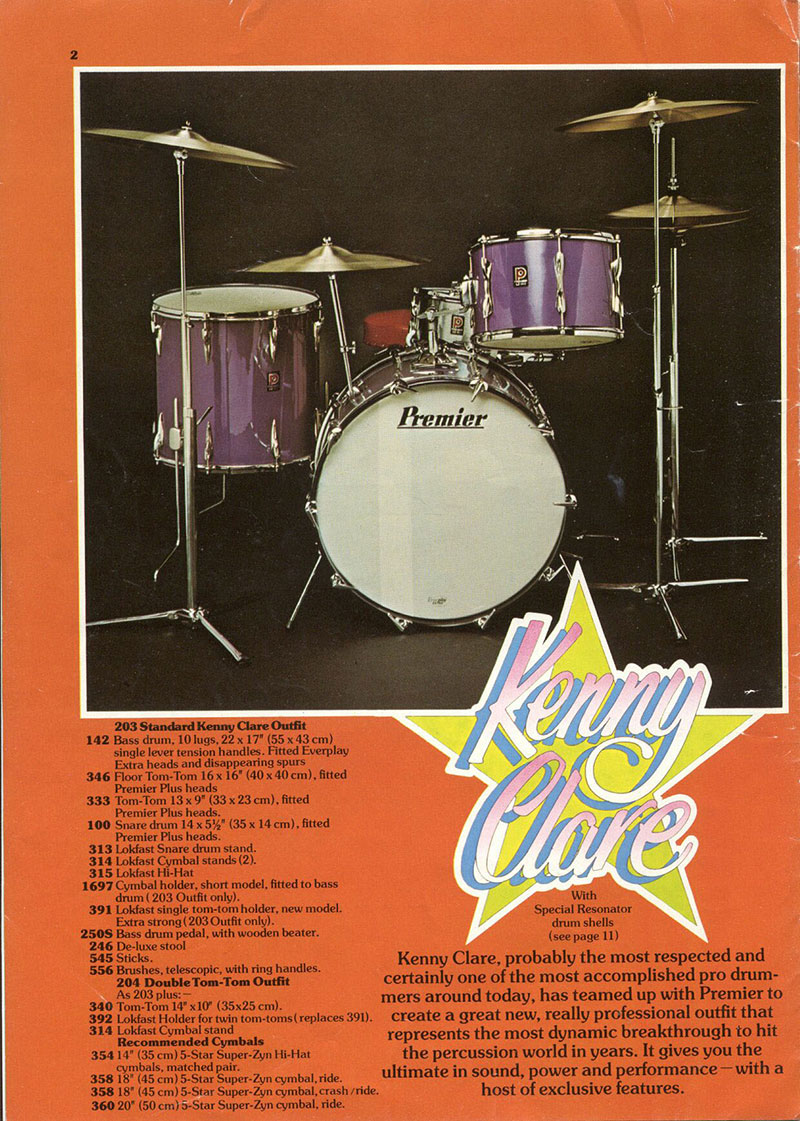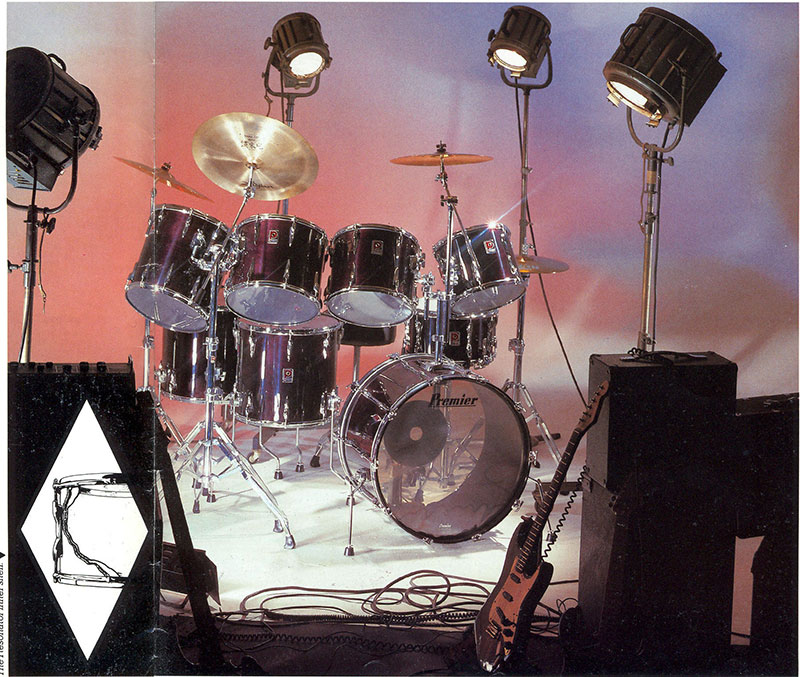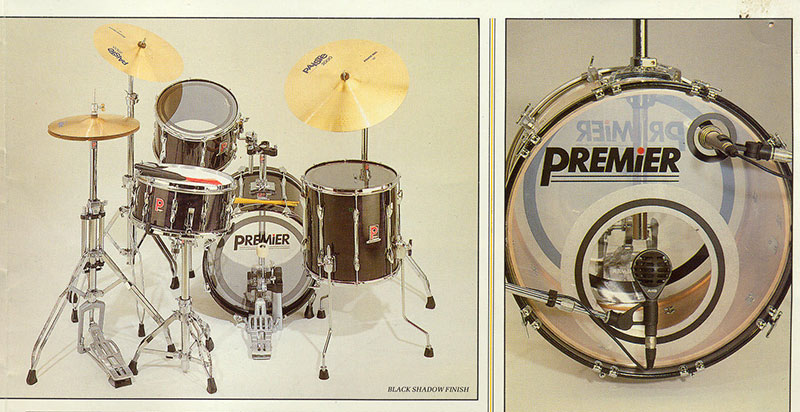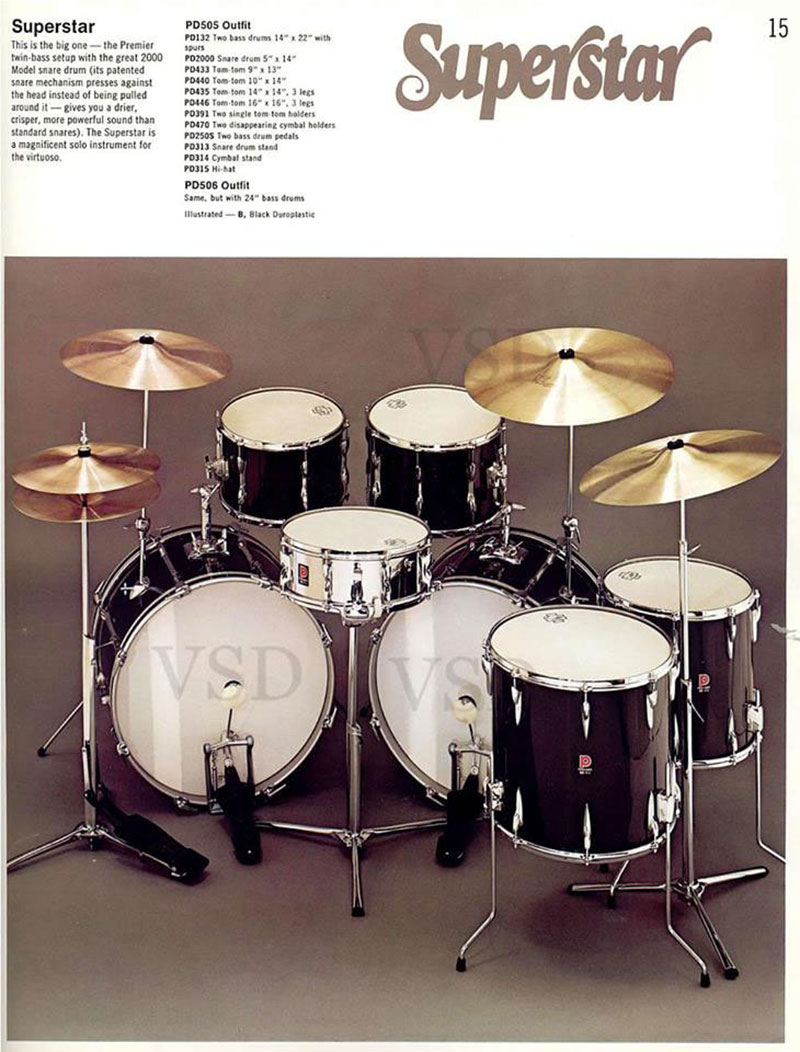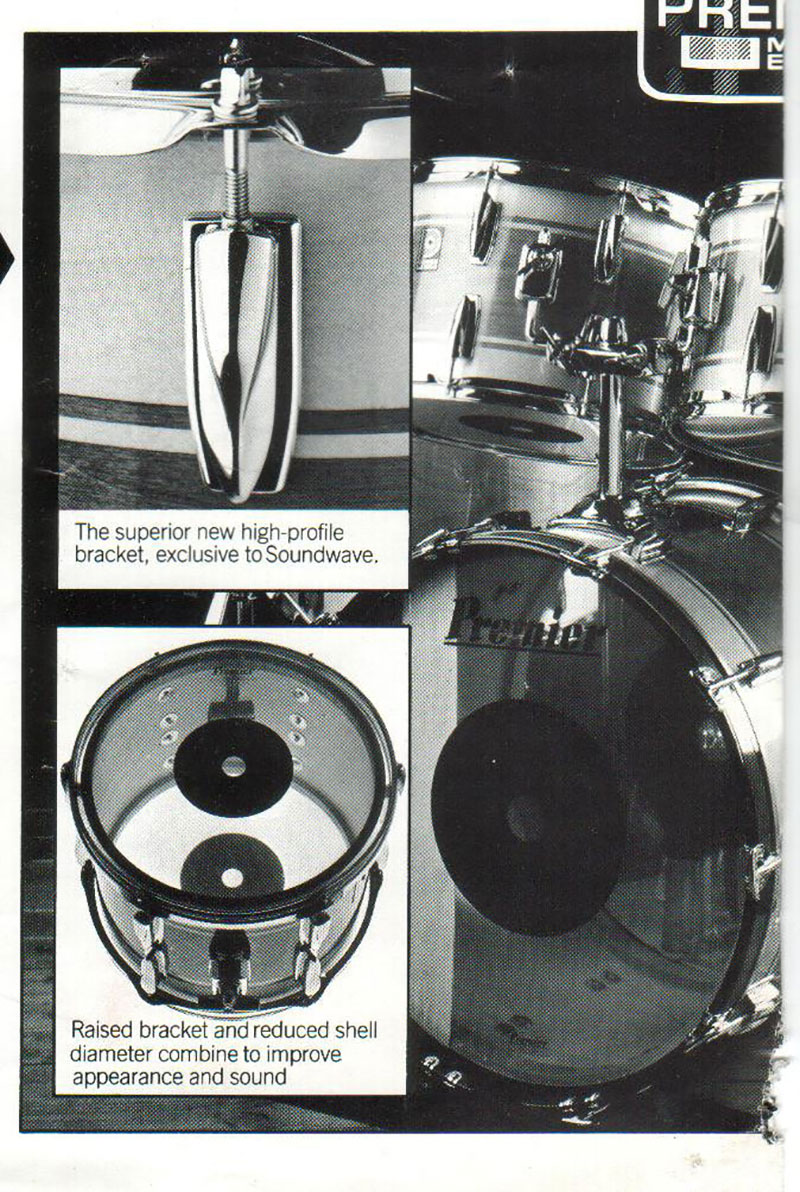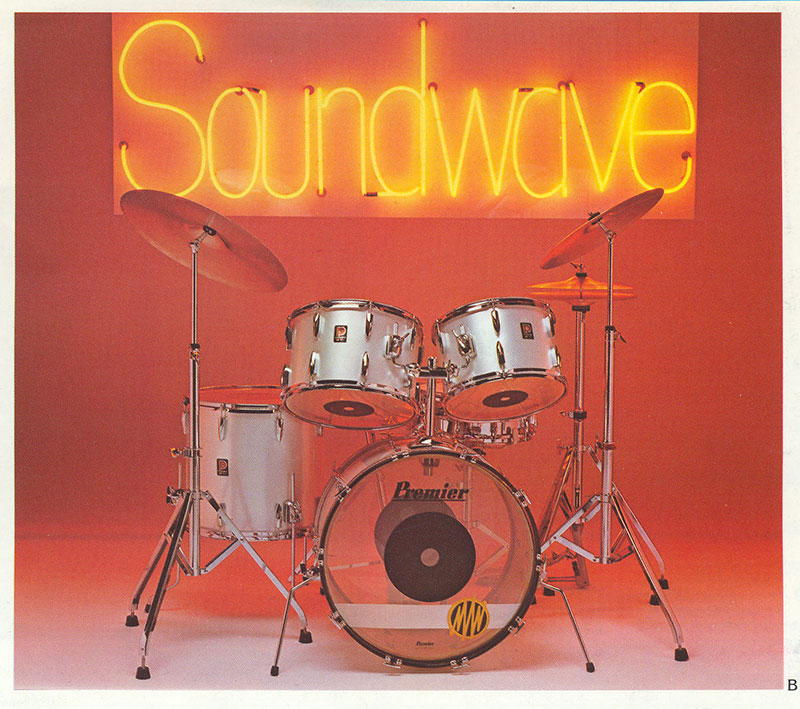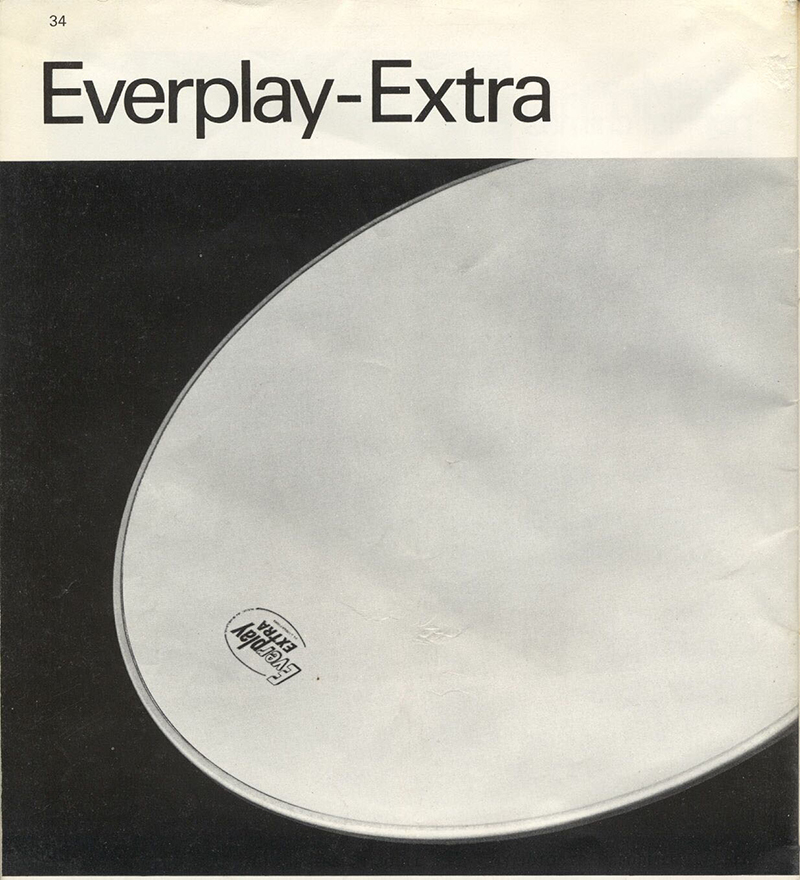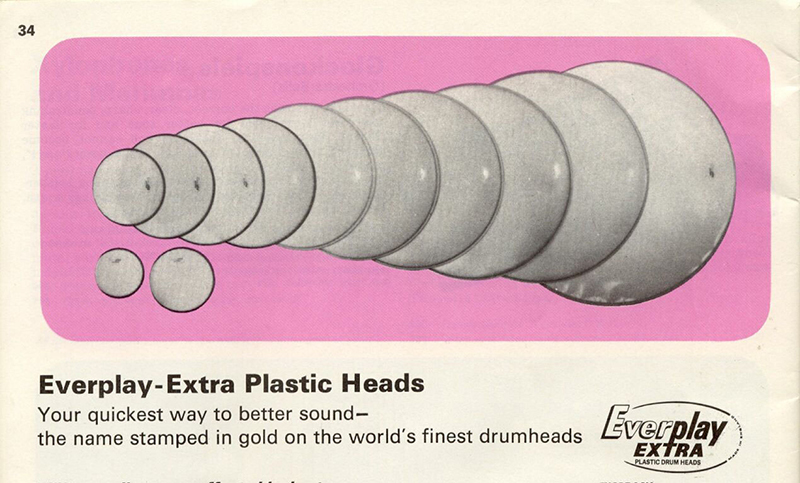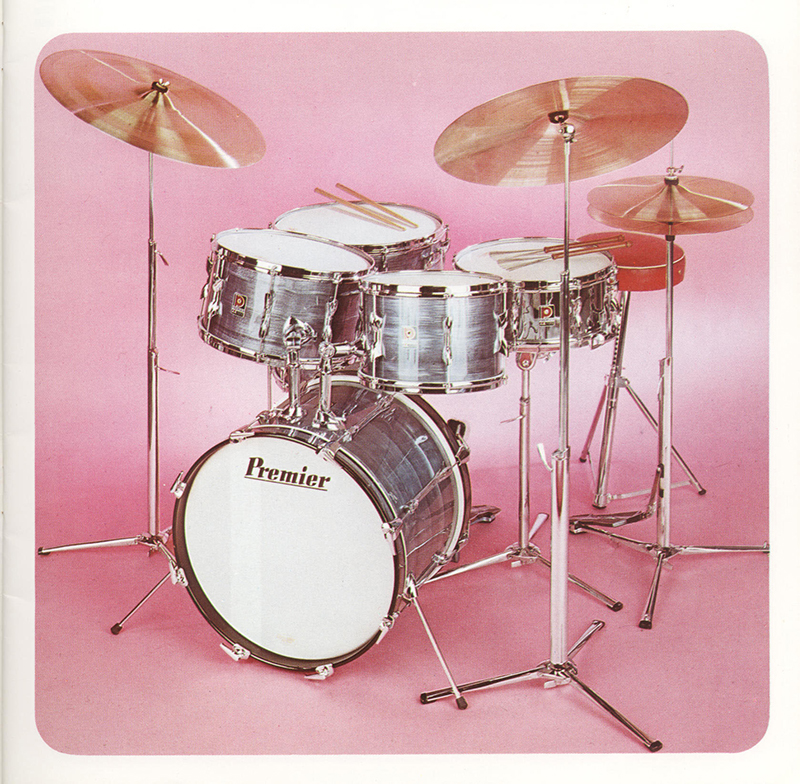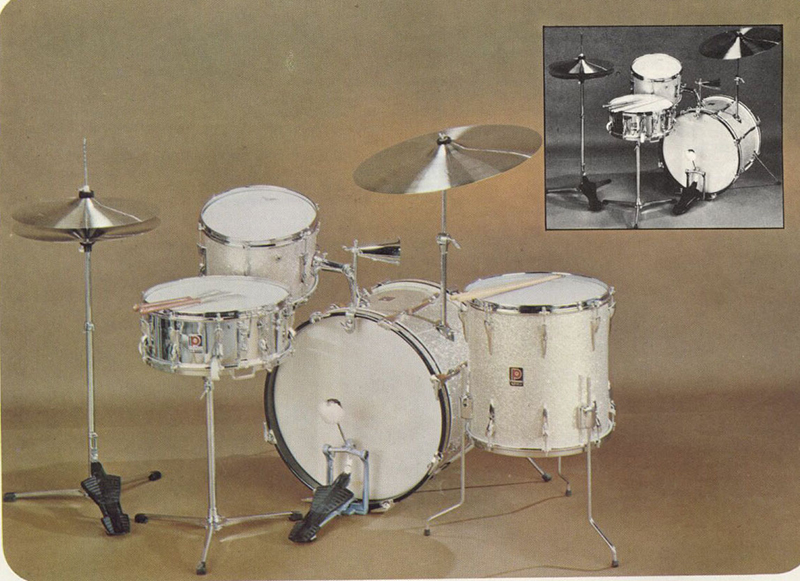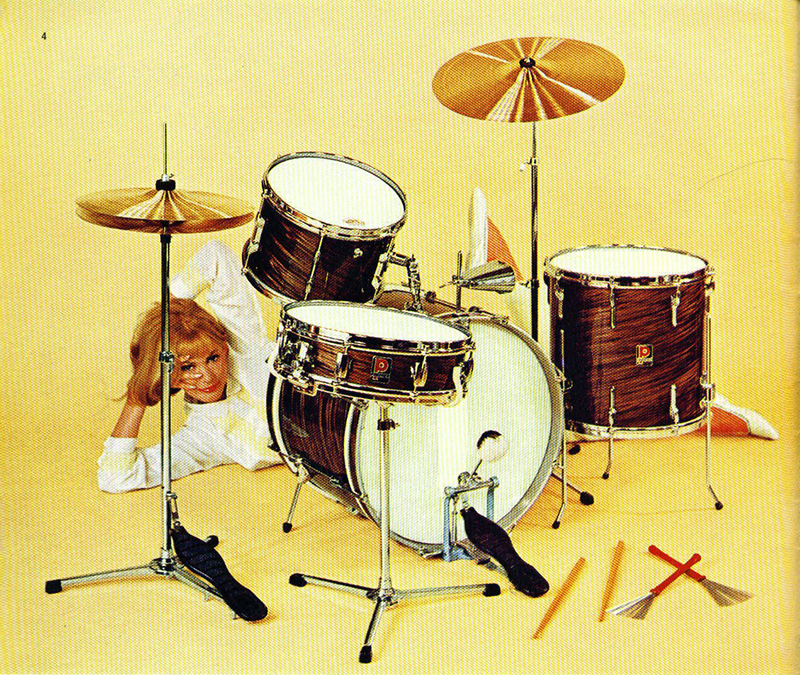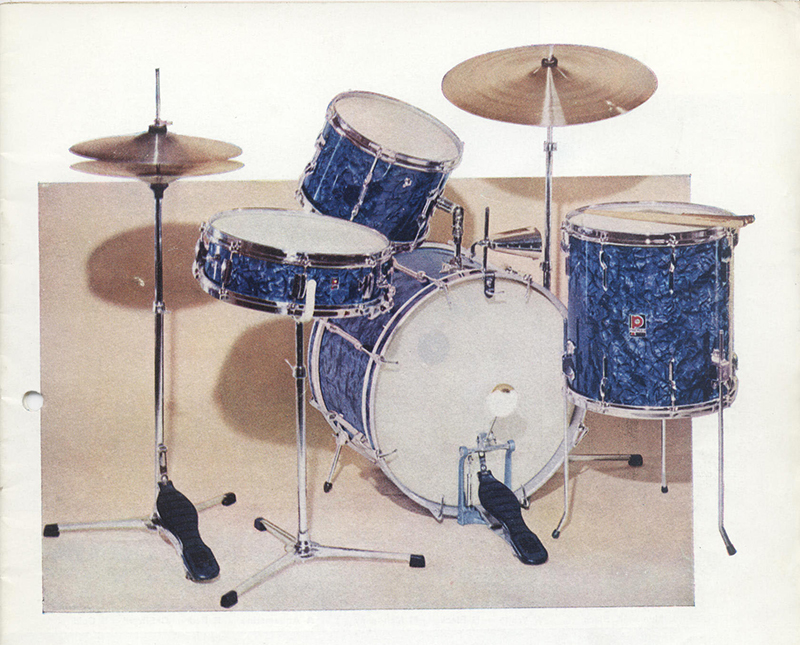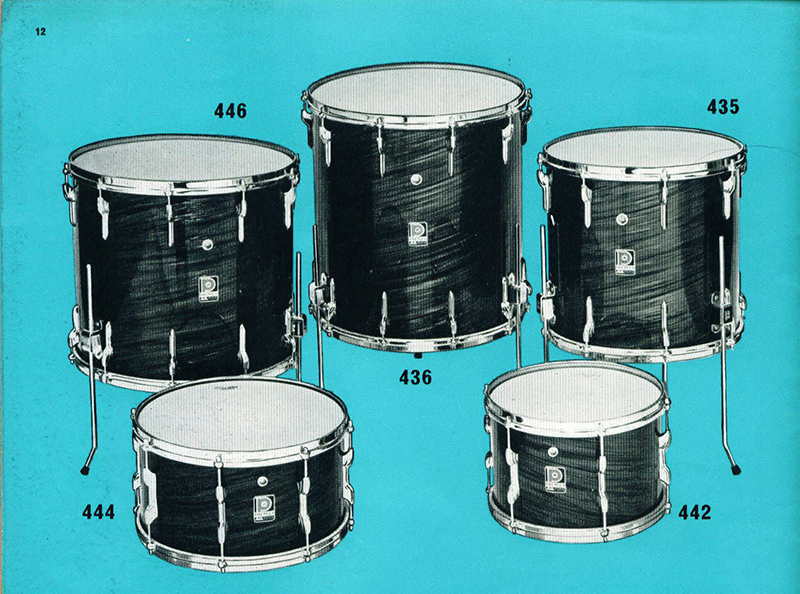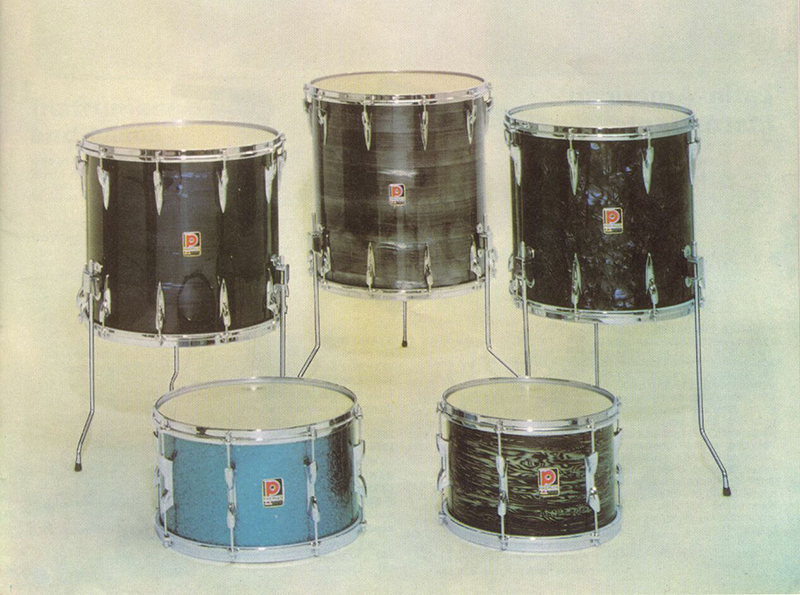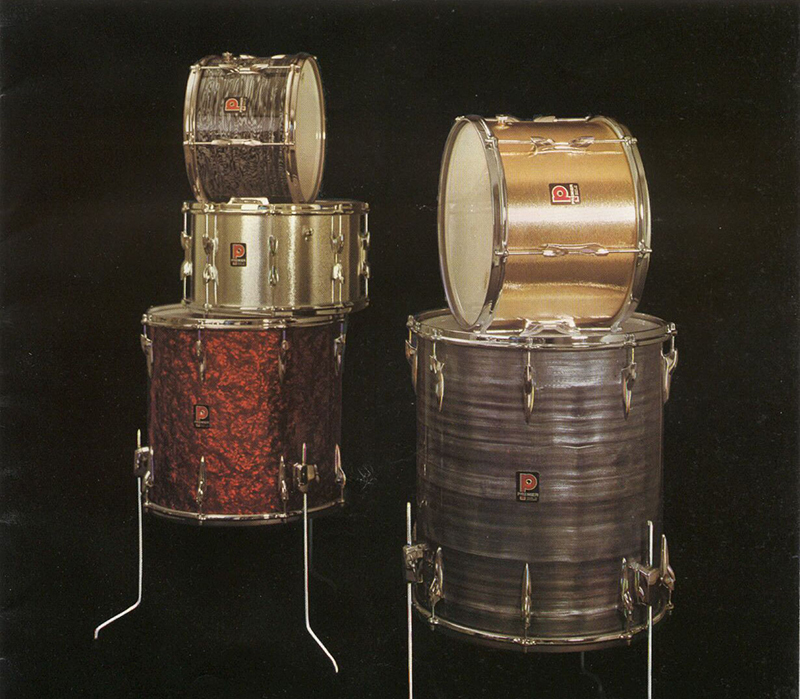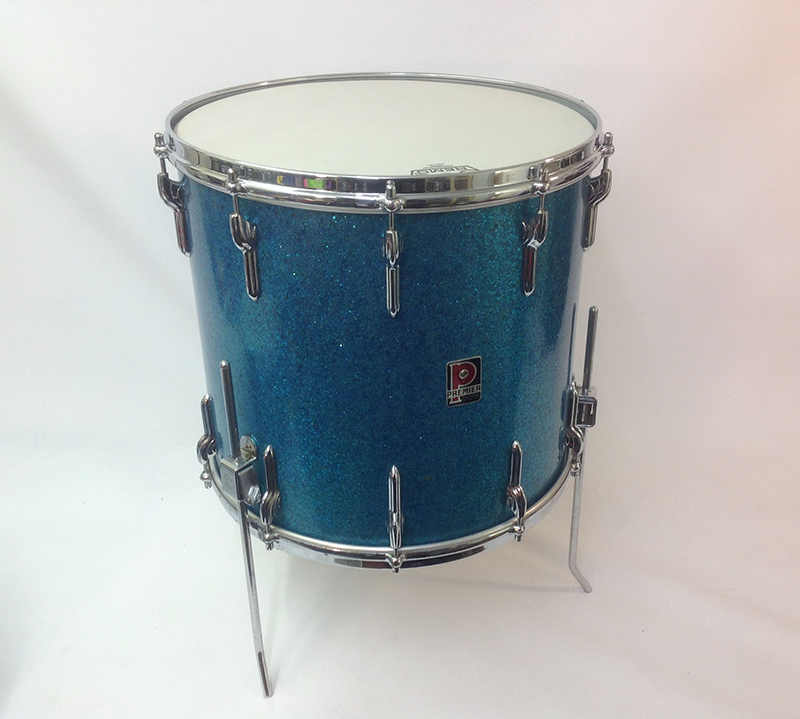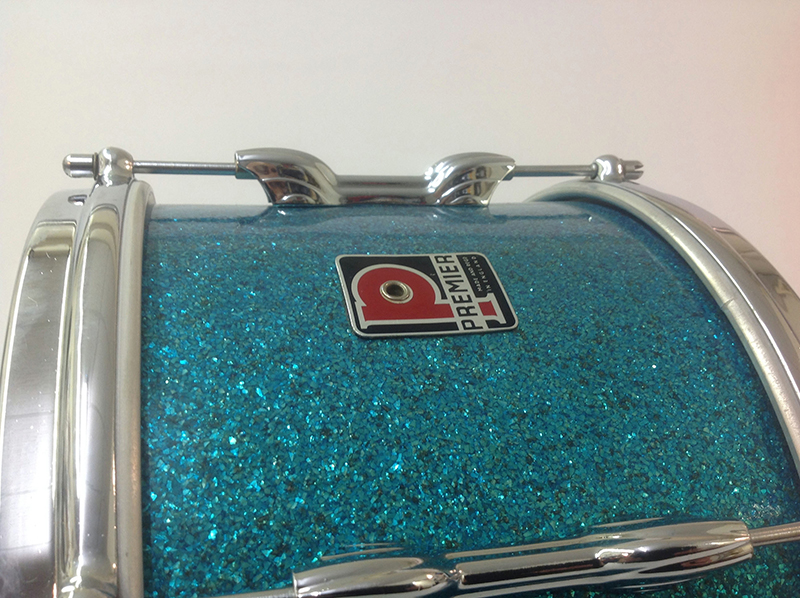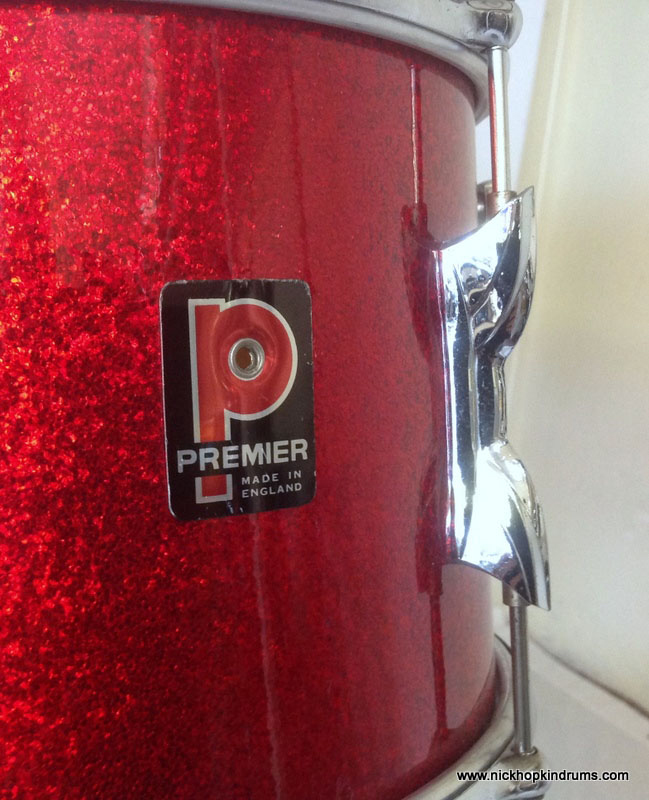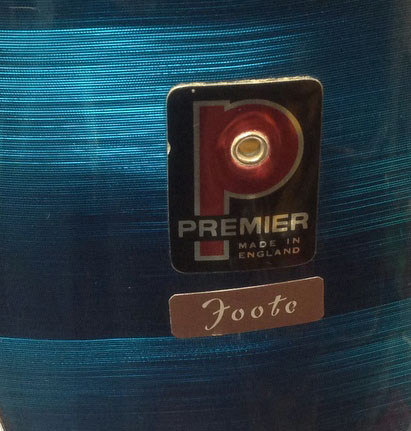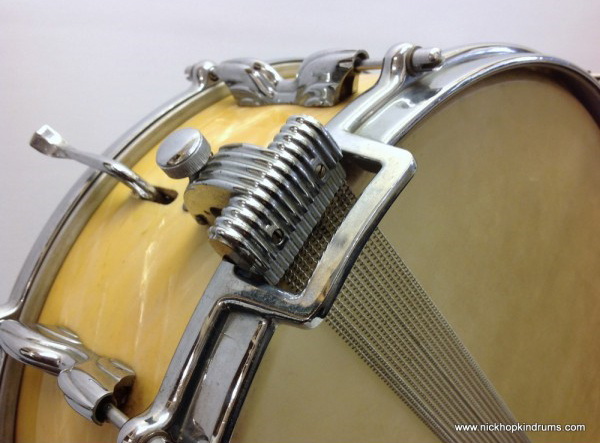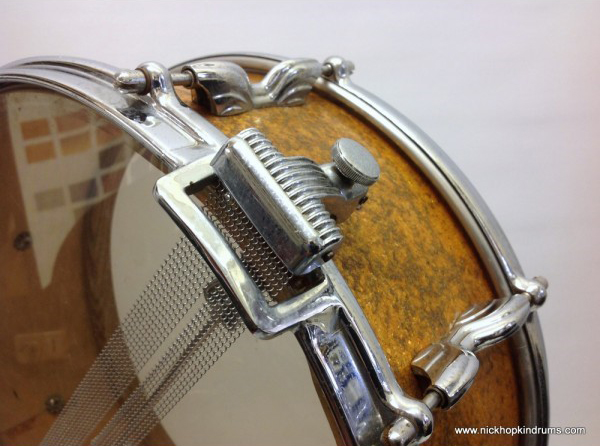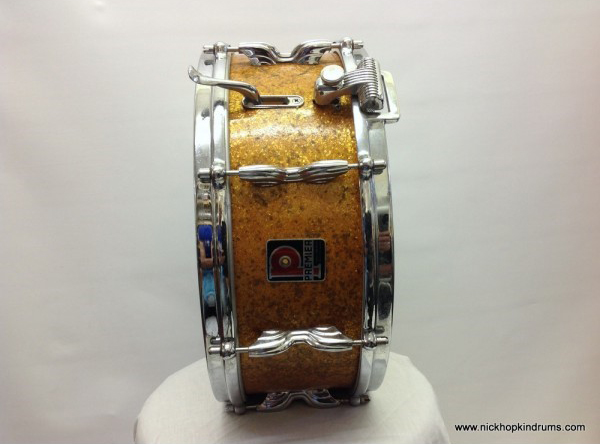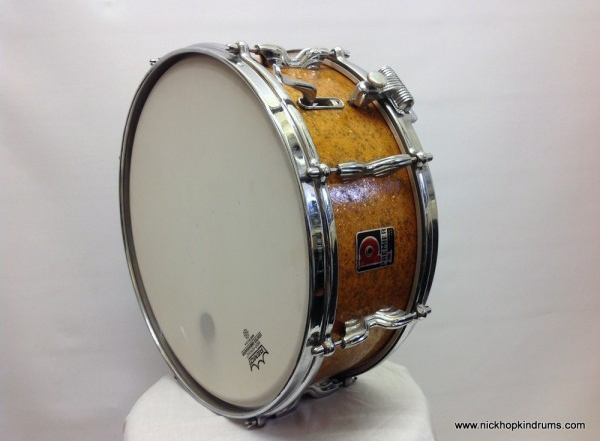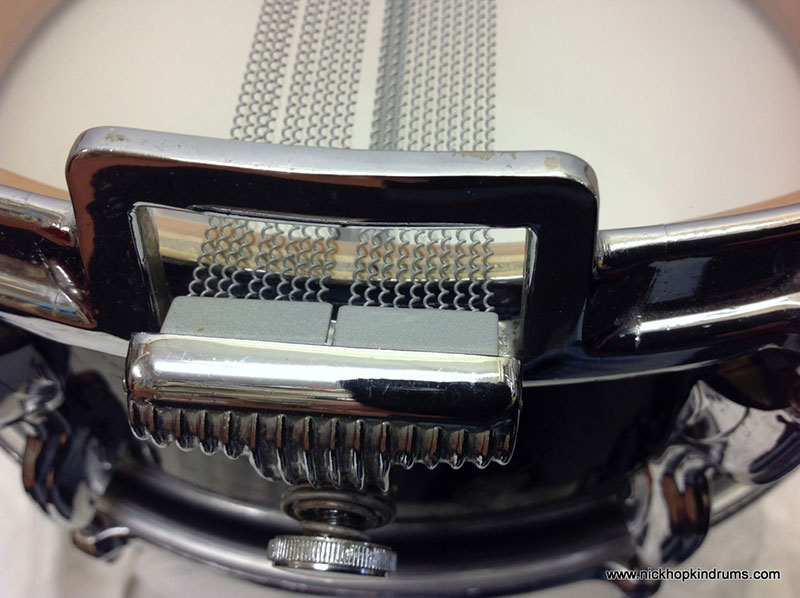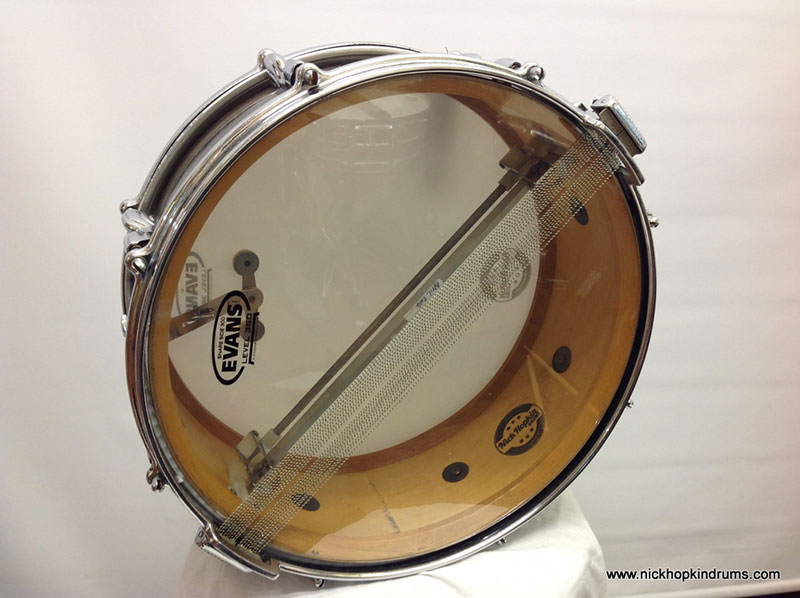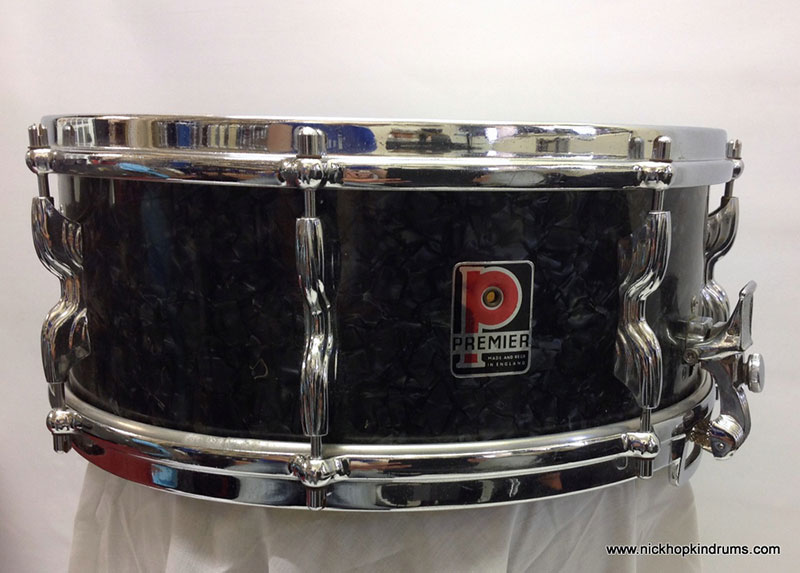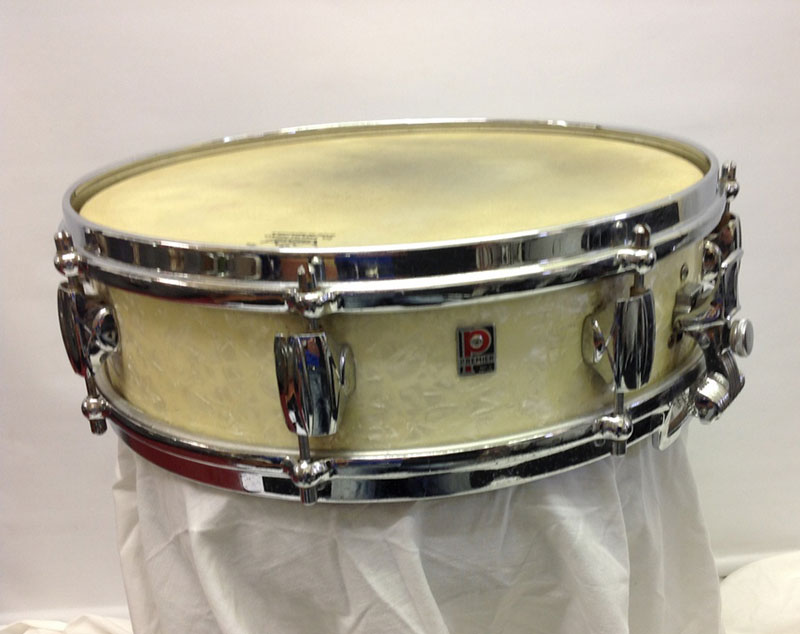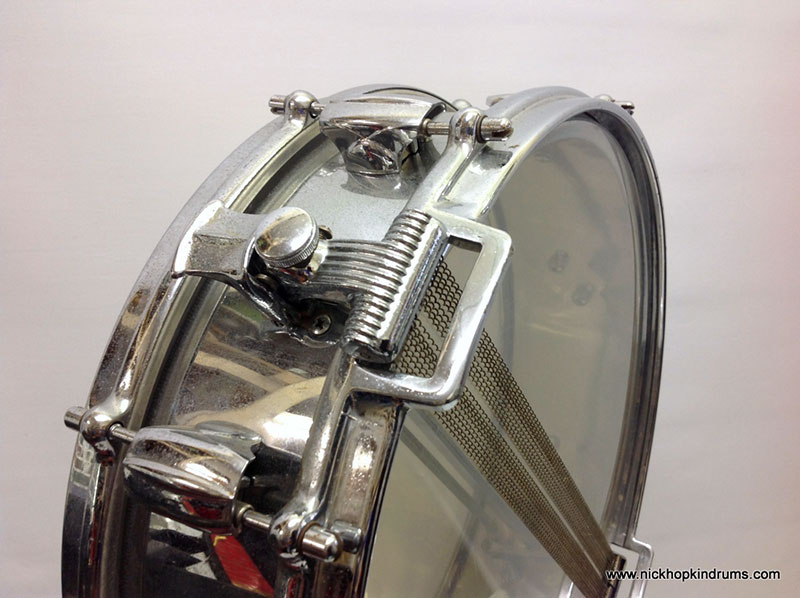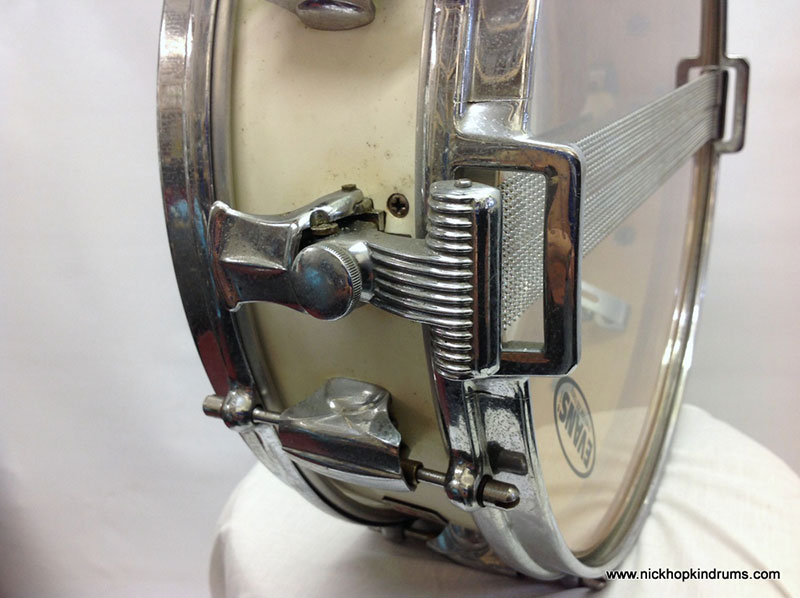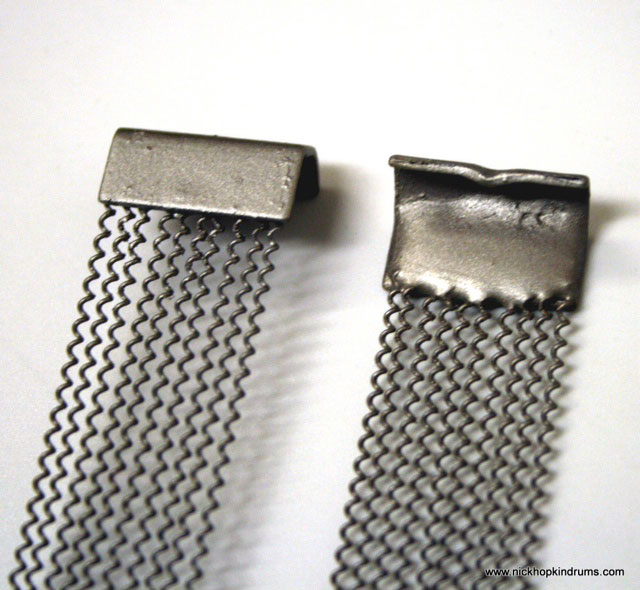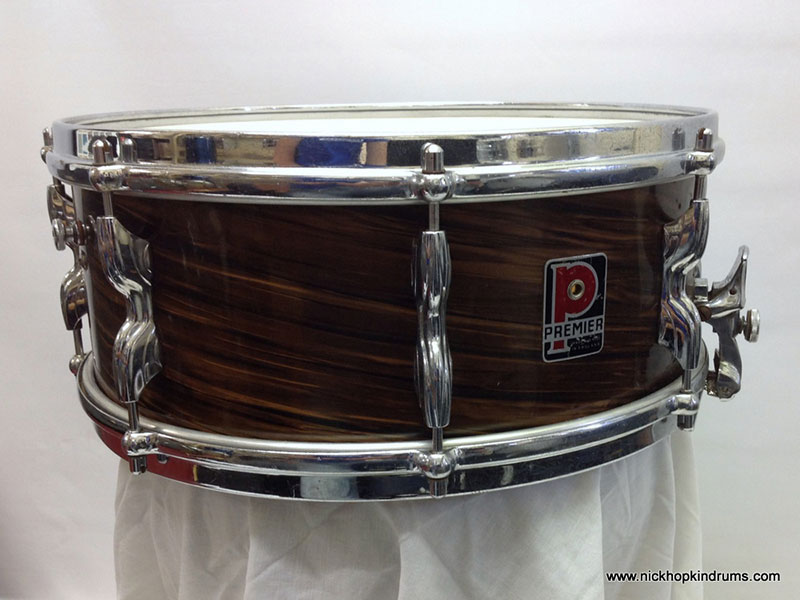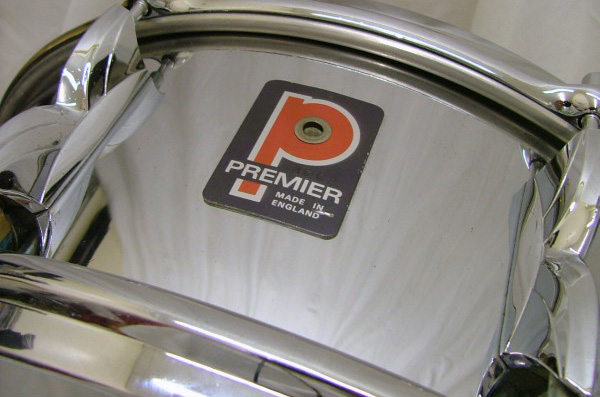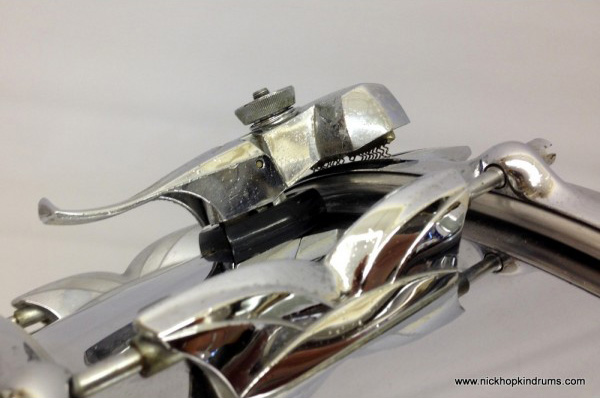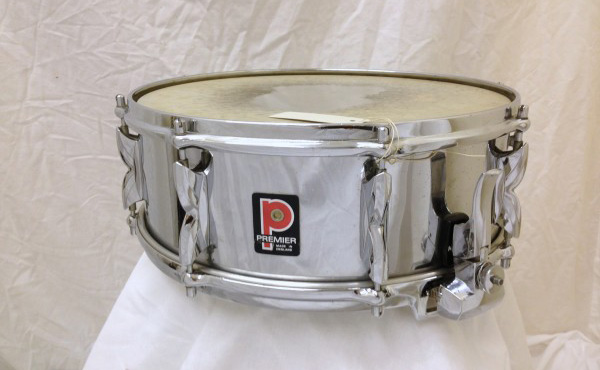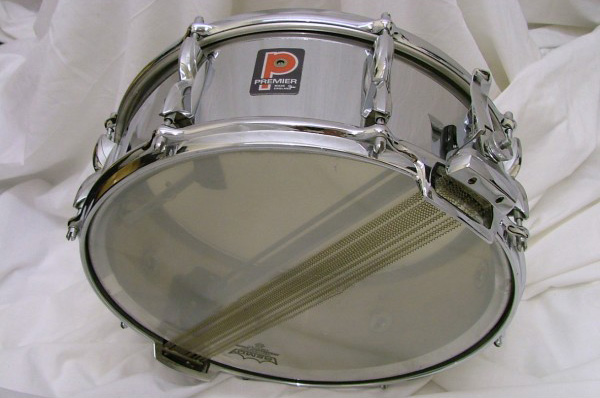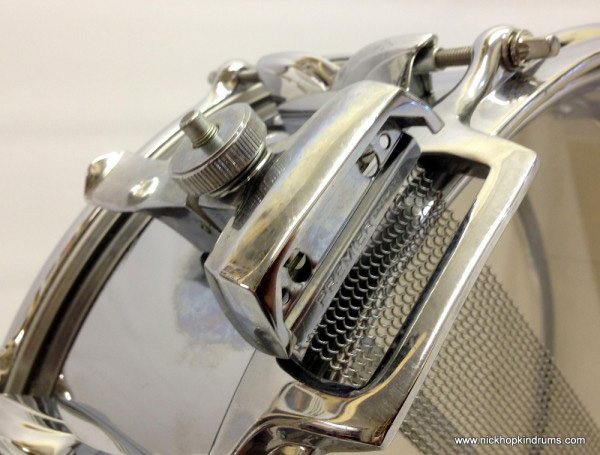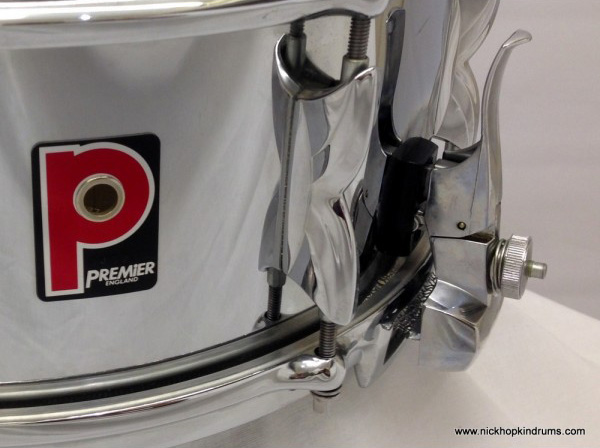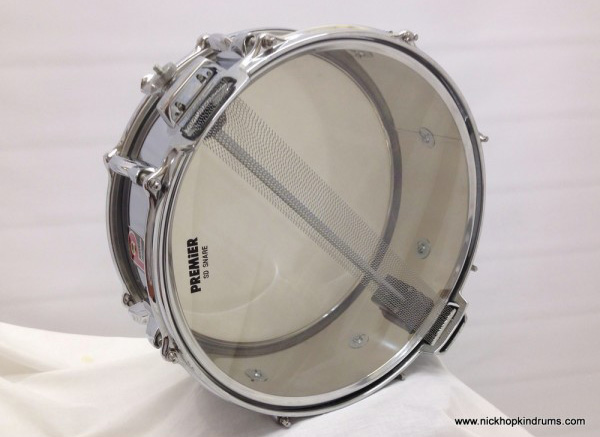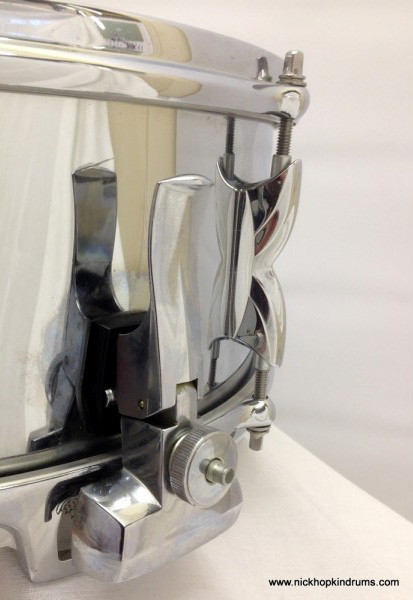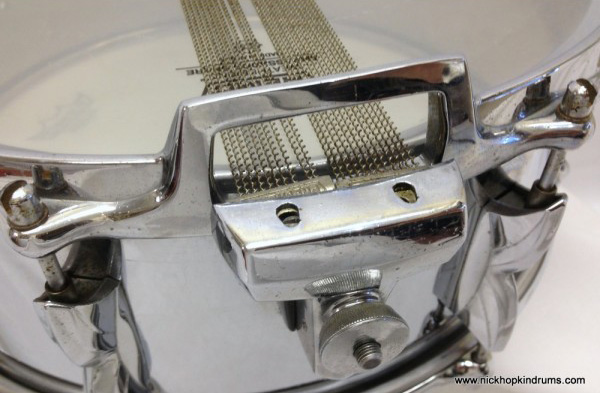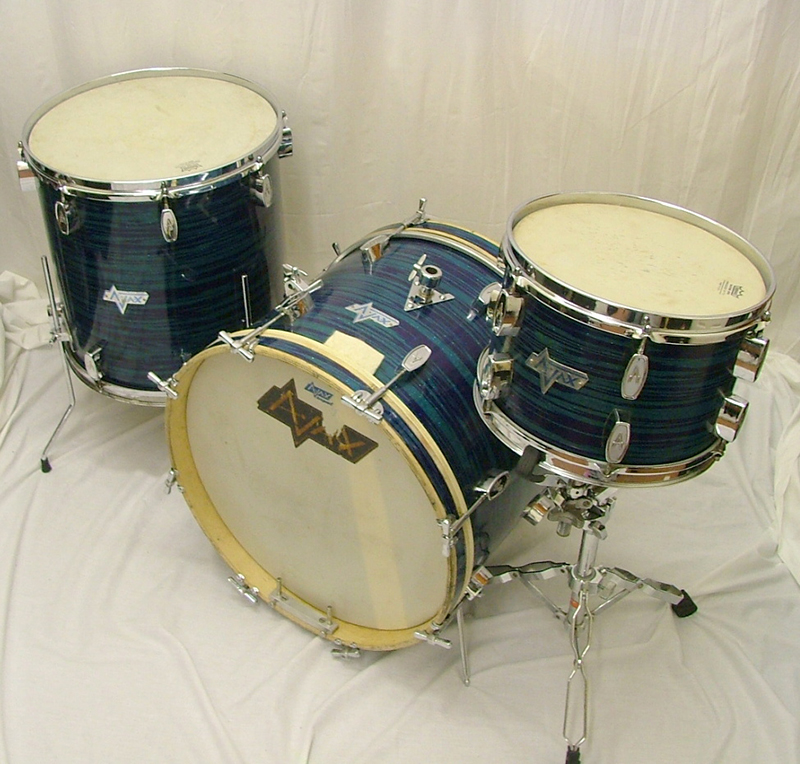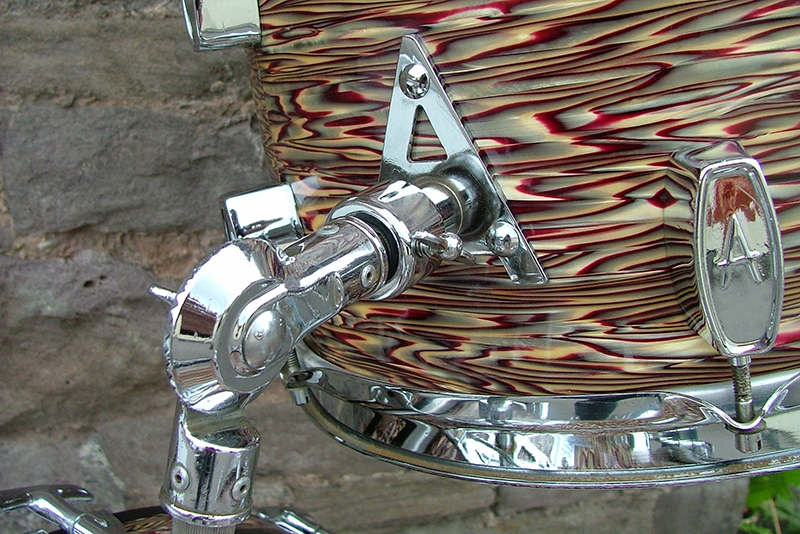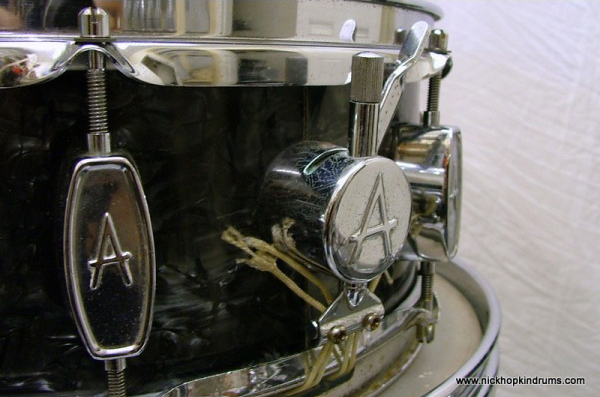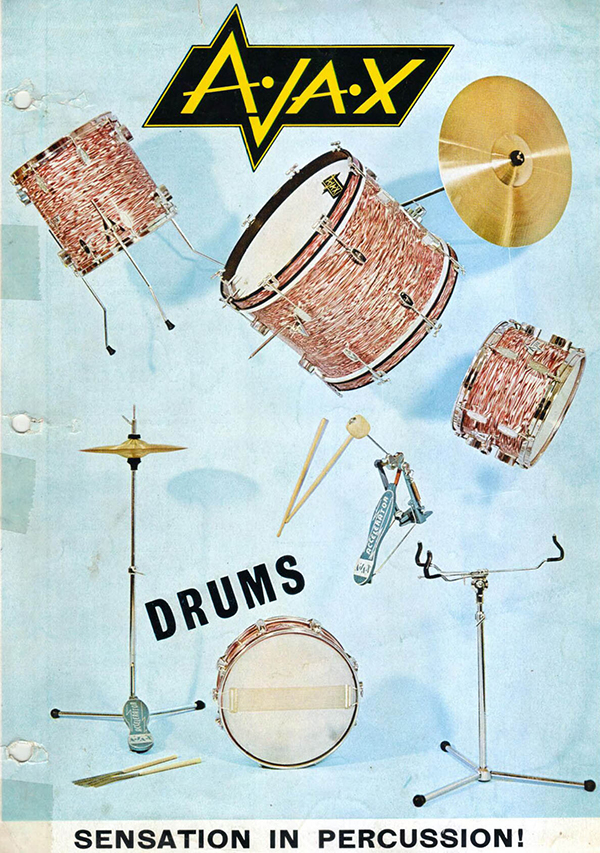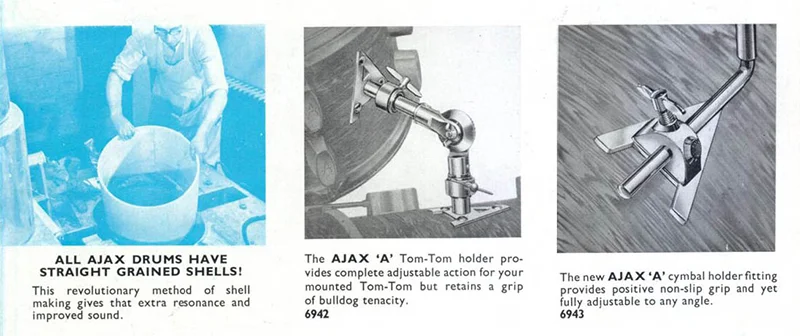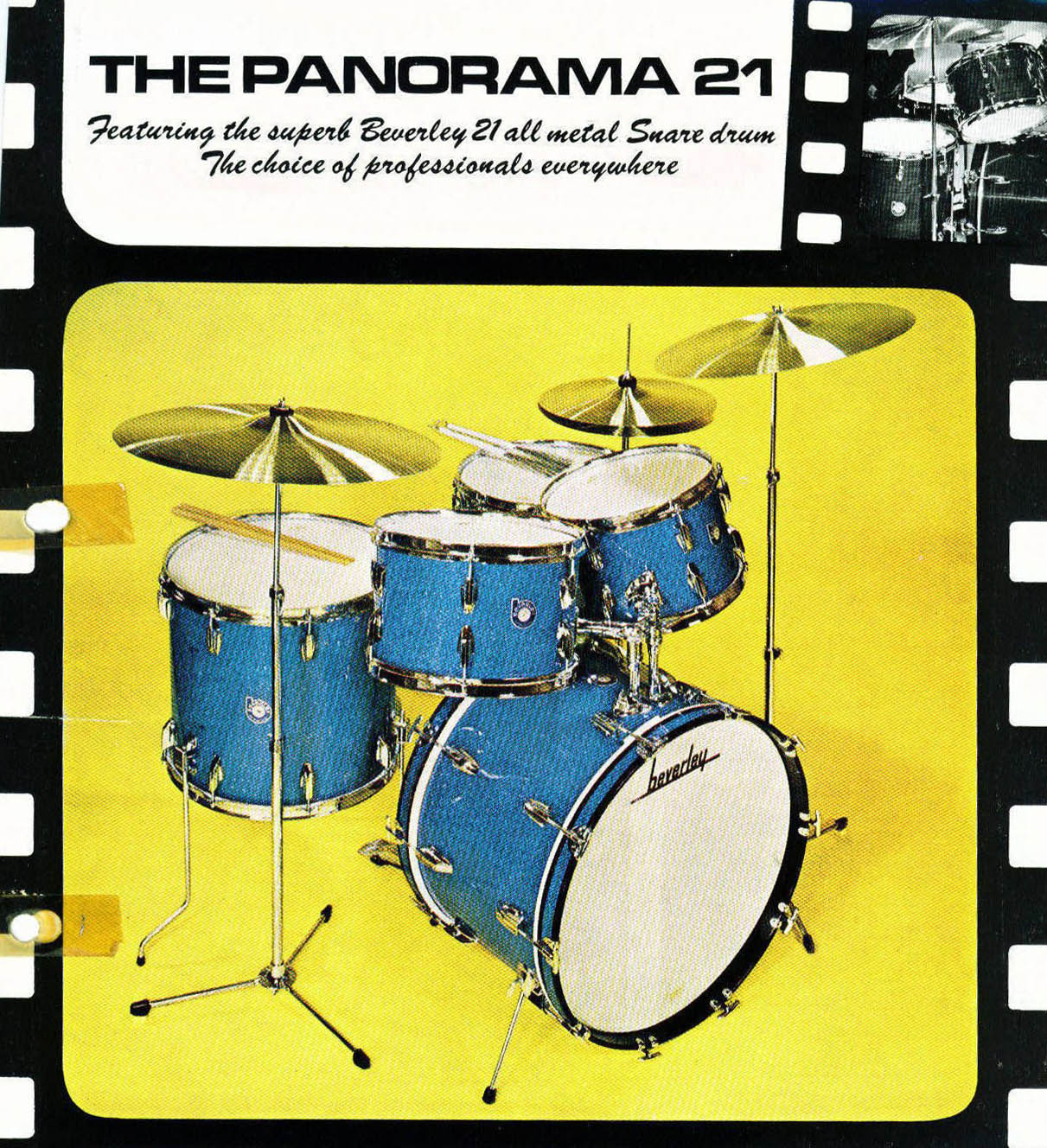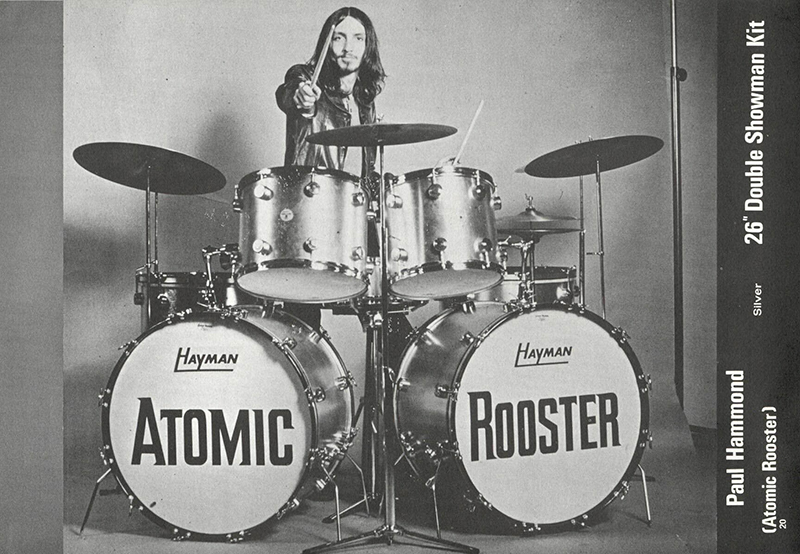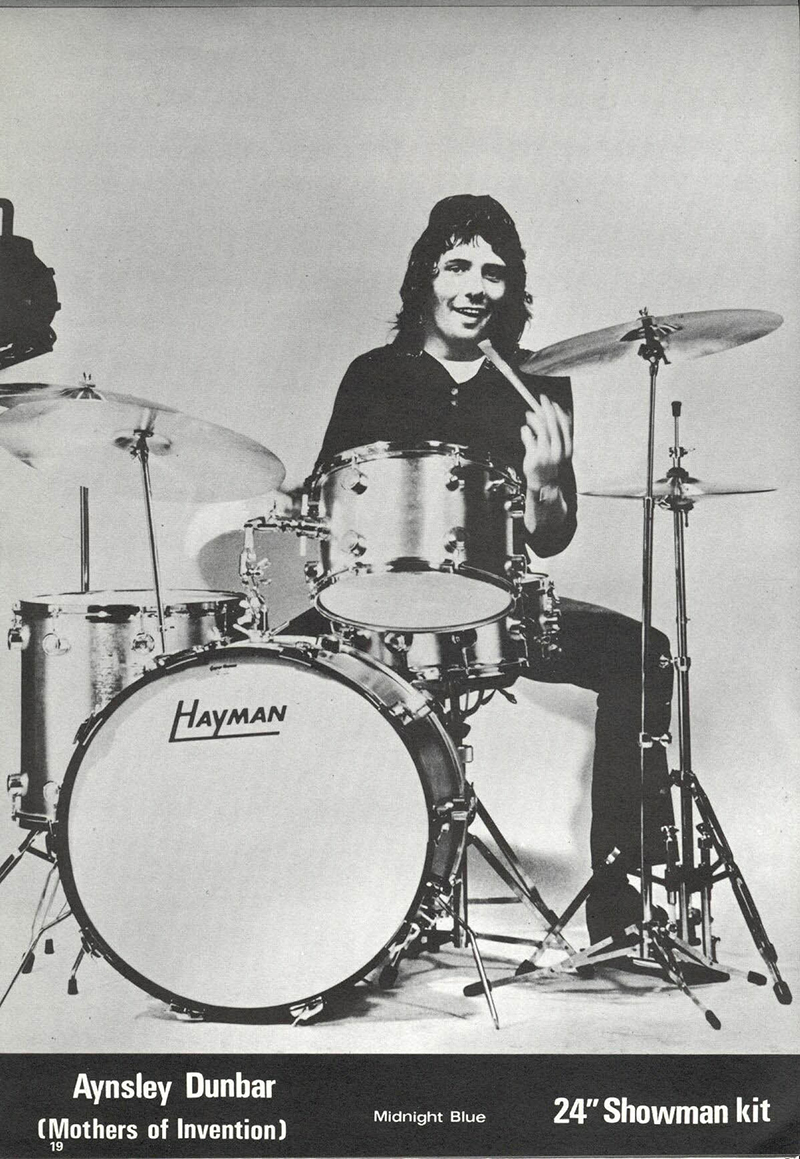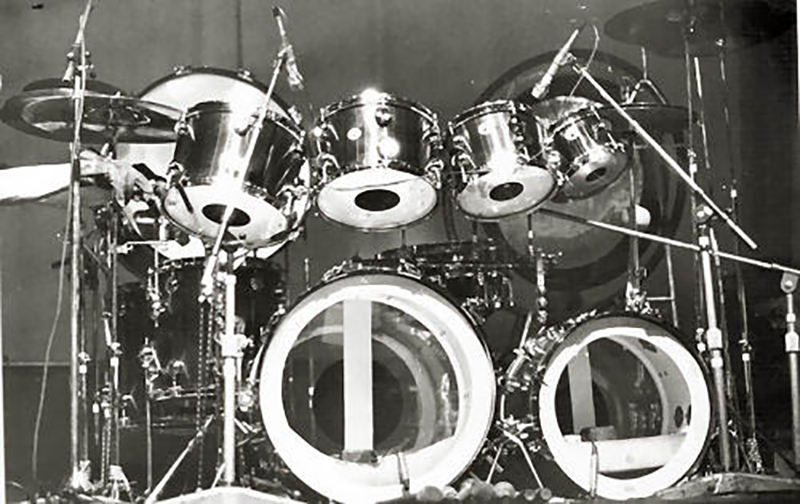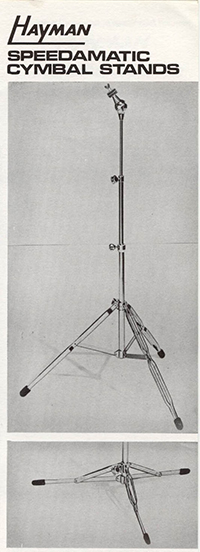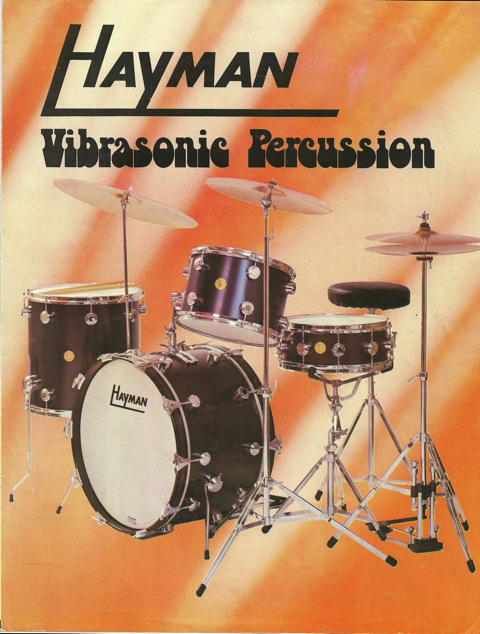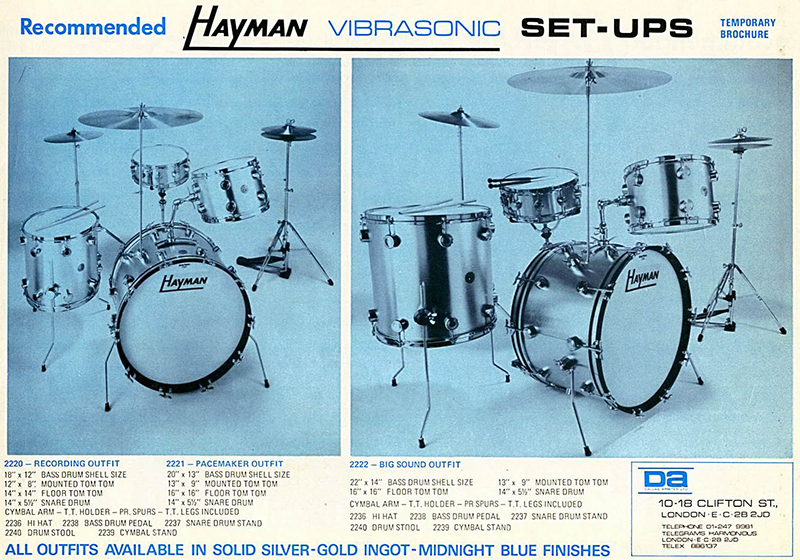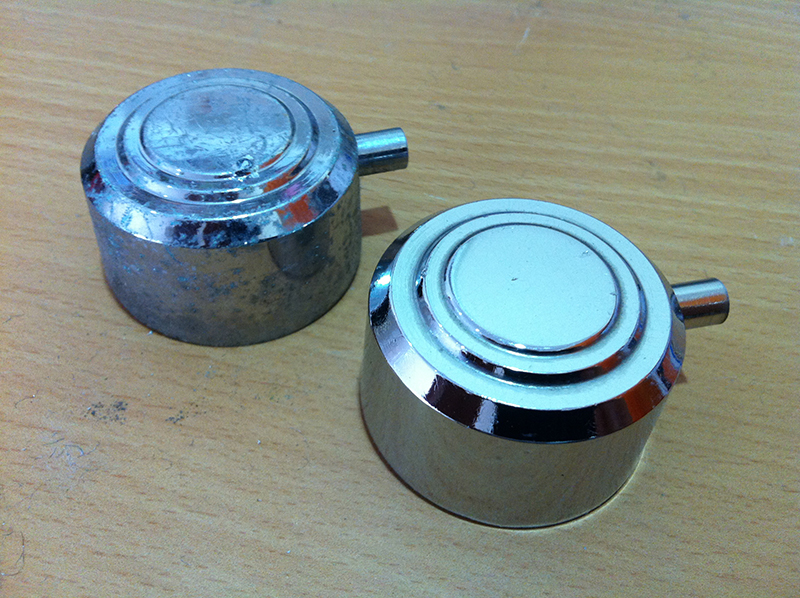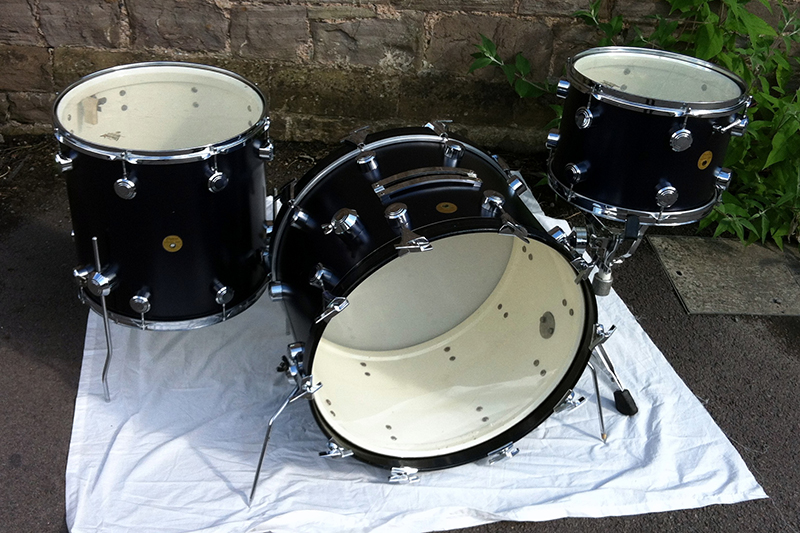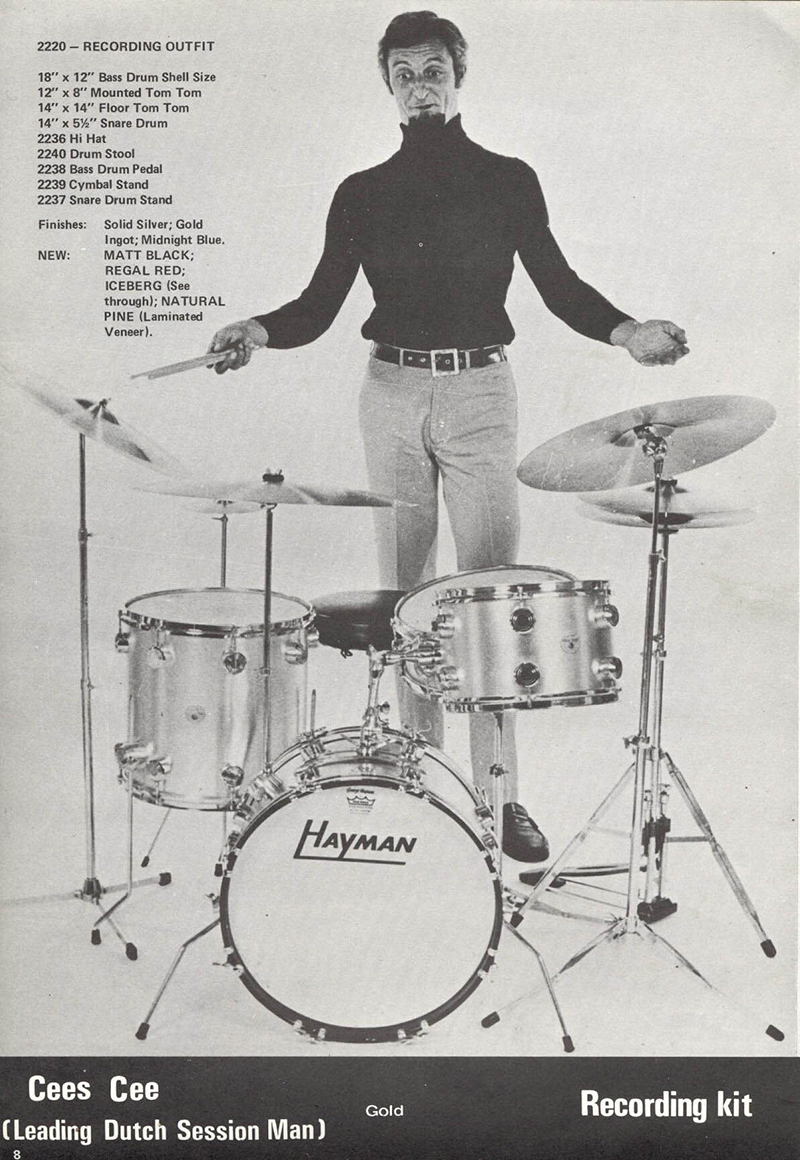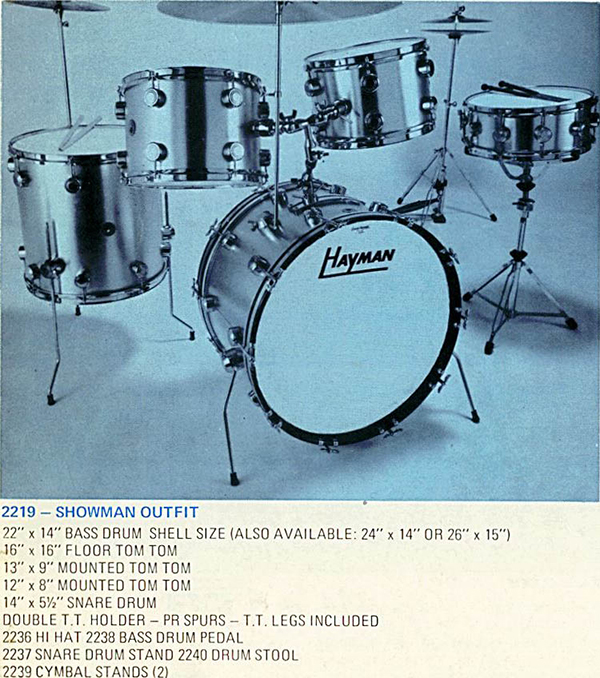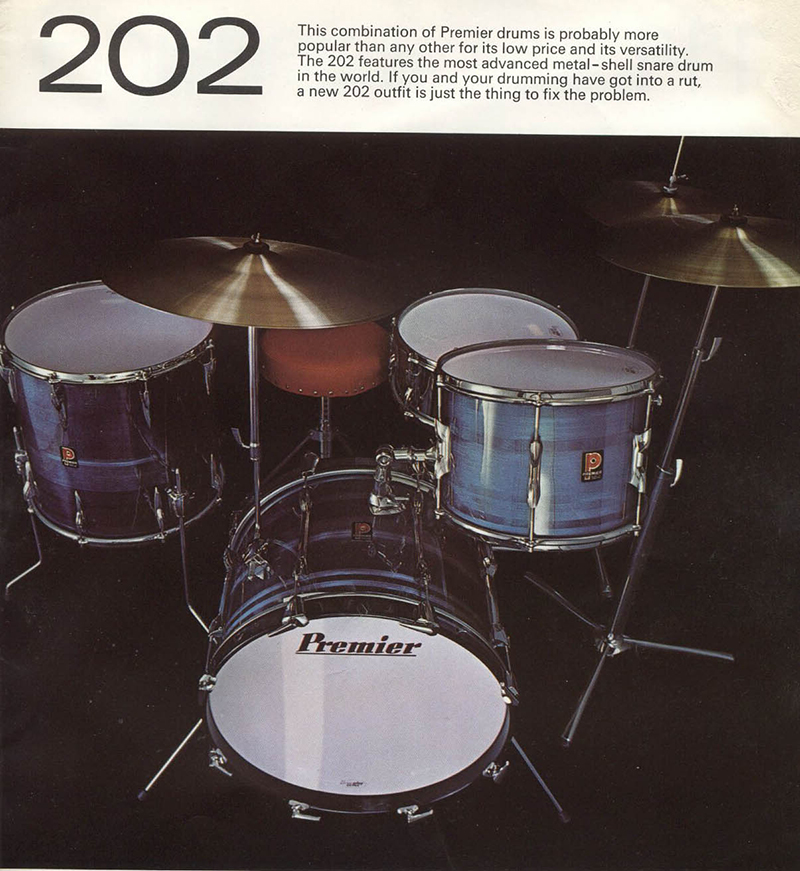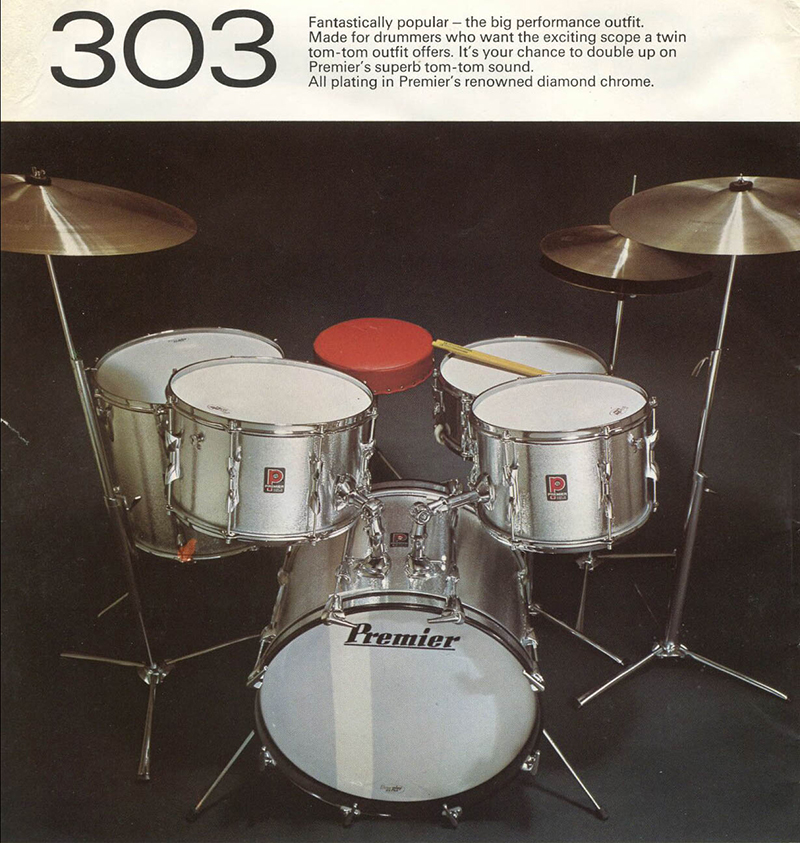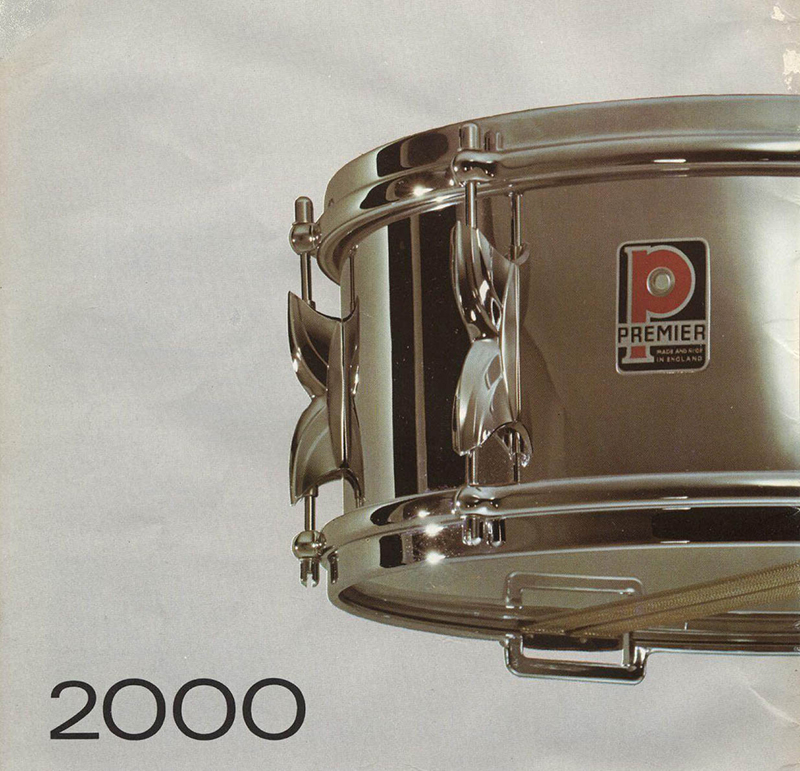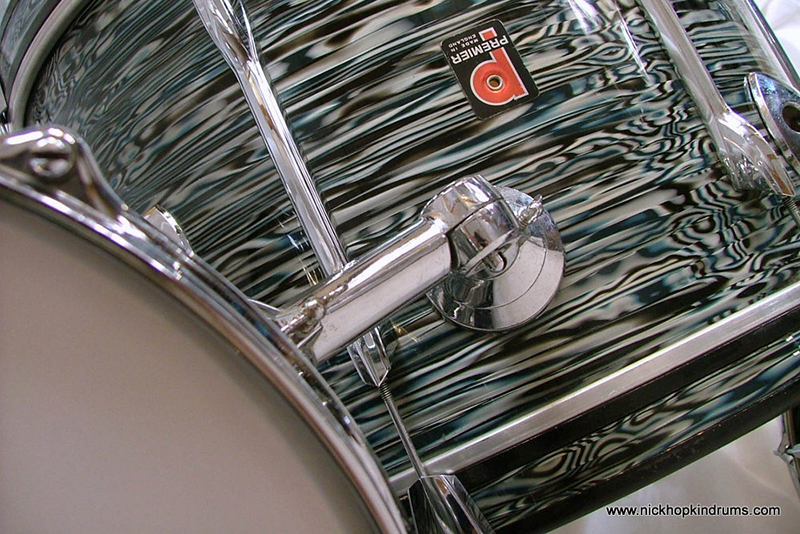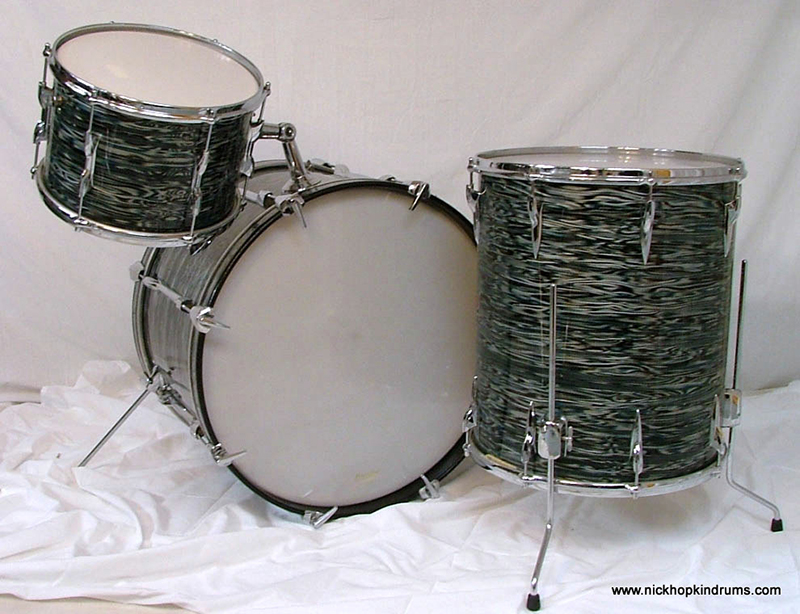This show is much smaller than Chicago but really well attended by both exhibitors and punters. Dealers from Germany, Switzerland and all across the Netherlands were there as well as myself with a great selection of vintage drum goodies.
Read morePremier B202 drum set - Golden Sun finish
Here’s a kit that only occasionally do I come across in original condition; A Premier B202 in ‘Golden sun’ finish. This particular set was bought new in 1970 and remained with that owner until a month or so ago. The finish is fairly rare or, at least, rare in good condition.
Read more1960s Carlton Drums
Although the English vintage drum market tends to be flooded with Premier, Olympic and Beverley drums, Carlton offered some really nice sets that often swoop under most people’s radar.
Read moreOlympic by Premier, drums from the seventies
This month I’m looking at Olympic drums from the 1970s. Marketed by Premier as ‘professional drums at inexpensive prices’ they were always viewed as cheap. Recently, Olympic drums have made resurgence and kits in good condition are steadily rising in price.
Read moreVintage Drums, Legendary Sounds
Between 1967 and 1972, Premier experimented with lots of different fittings and mounts on their drum sets; as discussed previously, many kits in circulation today don’t match catalogue sets as they are made up from shells and fittings from different models. One can usually determine the era of a set, but generally drums from this period are a mixture of shells and fittings so don’t fit specific catalogue configurations.
By 1976 Premier had settled on some hardware design choices, which became uniform across all models and these features remained through to the late 1980’s. The 1976/77 catalogue still gives us drum set model numbers - B202, 604,605, 606, etc and the B203 and B204 featuring internal liners (Resonator). However, we see the introduction of the 392-50 tom post mount and 392 double tom holder across all models, with matching bass drum and floor leg mount blocks. It’s noticeable that the sets in this catalogue mostly have 8 lugs on bass drum, but the larger sets such as the 305 and 717 feature 10 lugs on the bass, a feature that became synonymous with their flagship sets (Elite, Resonator, Soundwave).
1978/9 catalogue features three new kits – ‘Elite’, ‘Resonator’, ‘Soundwave’. Firstly I’m going to focus on the ‘Elite’.
Premier Elite drums, from late 1970’s
The Elite retains the individual model names from the previous catalogue, but all bass drums now feature 10 lugs except the 201 which is a 20,12,14 configuration. This is a set seldom seen and highly sought after. The bass drum featured fold out bass drum spurs with spikes & removable rubber tips. By now all shells were birch with beech reinforcement hoops, all toms came with ‘tone control’ dampers and all fittings were standard as mentioned previously.
‘Identified by their superb good looks and sound, and by the flush-braced tension brackets on double-headed mounted tom toms and bass drums, with matching styled brackets on snare drums and floor toms. This range gives you an incredibly wide choice of drum sizes, types and finishes.’
At a time when many companies still featured single lugs top and bottom on drum shells, Premier retained their ‘flush braced’ single lugs claiming that ‘they take most of the strain out of the opposing tension rods…so as well as looking good this takes the strain away from the shell allowing it to respond more naturally to your playing.’
Die cast hoops were standard on double headed sets, steel hoops on single headed concert toms. Single headed concert Toms were available from 6x6” up to 18x16” and double headed from 13x9” to 18x16”. Customers were encouraged to make up sets from a variety of options, which is why there are so many sets in existence that vary in configuration and colour. A lot of people get hung up on the fact that their kit wasn’t in the catalogue so isn’t original, but in truth the catalogues state that any size, combination and colour are available as custom orders with thousands of parts to choose from. All sets were fitted with Premier’s Blue heads and Lokfast hardware.
In the USA the set configurations that made up the Elite range had names such as ‘Baron’, ‘Kicker’, ‘Superstar’ and ‘Driver’ but like in the UK were available in custom configurations.
By 1980/81 production had moved to solid colours and we no longer see the pearls from the 1960’s and 1970’s. The typical configuration for the standard Elite set was 22,13,14,16 and although the 12x8 was still in production, double tom sets usually have a 13” and 14”.
The Elites were very popular kits in the 1970’s and early 1980’s played by many of Premier’s endorsers and remain popular among players and collectors today. Occasionally one appears in an unusual colour or with a stripe around the shell, probably a custom build. Most commonly they are in Polychromatic Gold, Red or black.
Premier Resonator, from mid 1970’s
Another of Premier’s flagship kits that originated in the 1970’s was the ‘Resonator’.
The Resonator was the brainchild of Alan Gilby who, in 1972, had experimented with metal liners in some of Kenny Clare’s Ludwig drum shells. The principles & design was developed with Premier, and so was born the Resonator; a drum set that had normal drum shells with a thinner 3 ply wooden ‘resonator’ liner sprung inside. The outer shell mounted all the hardware, leaving the resonant liner free to do its job as a smooth sound chamber, enhancing the drum’s projection.
The first Resonator was named the ‘Kenny Clare’ and appeared in the 1975 catalogue boasting ‘a new really professional outfit that represents the most dynamic breakthrough to hit the percussion world in years. It gives you the ultimate in sound, power and performance…’ Anyone who has seen these drums close up would immediately notice discrepancies between Alan Gilby’s original concept and Premiers production, namely by the fact that the bass drum spurs and tone control dampers fitted to the drums pierced the resonant liners!
It wasn’t until the late 1970’s with the fold out bass drum spurs and other fittings that had been standardized, that the Resonator’s internal liners were smooth and unhindered by any hardware (apart from the 392-50 tom post mount on the bass drum). Alongside the Elite, the Resonator was one of Premier’s flagship sets and remained so for a number of years.
It should be noted, that Gilby’s original design prescribed that the inner liners would act as the drums bearing edge with the heads resting on these rather than the outer shells. I have seen this feature on a couple of early sets from the mid 1970’s, but by the late 1970’s and early 1980’s the liners on all sets were flush with the bearing edges, which were standard Premier profile.
The resonator kits were essentially Elites with a resonant liner fitted – birch shells, with 3 ply beech sprung inside the shell - 10 Lugs on the bass drum and die cast hoops on the toms. The resonator had colour options available that other sets didn’t, mostly a choice of coloured band around the shells. As with all sets, sometimes a colour appears that has all the Premier drummers discussing in forums as to whether they’re original, but again it is to be noted that just because it isn’t in a catalogue doesn’t mean it doesn’t exist! Premier offered custom options on all their high end sets, so anything was possible.
They became popular among drummers on both sides of the Atlantic, due to the power and volume of the shells; most famously endorsed by Clem Burke who used them throughout his career in Blondie and right through to his work in the 80’s with Eurythmics.
In the early 1980’s Premier introduced the Black Shadow Resonator, which featured birch shells with the toms in power sizes, described as follows in the catalogue: ‘the finish is unique; a black glass like surface is achieved in a special process that takes no less than 8 days to complete. It captures the natural wood grain perfectly, wrapping it in a deep, dark shroud that subtly reflects and retracts ever changing hues of black with the shifting light.’ The first series of Black Shadow Resonators featured two sets of single lugs on the toms, but by the late 1980’s design had changed to flush braced lugs the length of the shell, in line with other Premier sets of the era. The Roklok tom post mount replaced the oval 392-50 mount and the tom post gave the option to mount a cymbal arm. Alternatively, one had the option of the Fastball tom post. Lacquer finishes were standard in white, red or black with matching lacquered liners. Premier introduced some bright colours in this era, offering yellow, blue and pink with matching liners! These are rarely seen, but really stand out from anything else on the market at the time.
While other companies were realising that clunky hardware attached to drum shells killed resonance, and so began to introduce Rims fittings to toms, Premier argued that their resonator shells had solved this issue a decade before. Premier ceased production of the Resonator in the early 1990’s but they remain a popular kit among players and collectors, in any of their models during their two decades of production.
Premier Soundwave, from late 1970’s
Premier’s other flagship kit that appeared in the late 1970’s was the Soundwave. This set differed from all other Premier drums at the time due to various new features. ‘Instantly recognisable by the smartly designed separate tension brackets on each tom tom and bass drum’ boasted the 1978-9 catalogue ‘offering a free, more vibrant sound.’ The drums featured steel hoops rather than die cast, and the tension rods were square rather than slot headed, offering a much more modern image in keeping with their competitors. All shells were birch with beech reinforcement hoops, fitted with tone control dampers and the same hardware mounts as the Elite and Resonator. Like the Resonator and Elite, bass drums featured 10 lugs. They were generally marketed as a double headed tom set, although concert toms were available, and factory fitted with clear, black dot heads.
The catalogue stated that the drums were ‘available in any finish’, and that despite the lug design differing, the drums could be mixed with those from the Elite range. Rick Buckler from The Jam had a white set that was custom built by Premier, containing a mixture of Soundwave and Elite shells in power sizes. By the early 1980’s, the hardware that came with these sets changed from the ‘Lokfast’ to ‘Trilok’ – heavy duty tripod stands, a move away from the flush based models from the 1960’s and 1970’s.
Sometime around 1982 the Soundwave Mk II was introduced with a slightly reduced shell diameter, allowing the head to overhang the shell improving sound (and maximising bearing edge/head contact). The design of the drums remaining the same as it’s first incarnation, but the lugs were fitted with plinths to raise them from the shells. (These undersized shells are not to be confused with the pre international drums of the 1960’s, the Soundwave sets took standard size heads). Bass drums were listed as being available from 20” to 26”, and double headed toms from 12” to 18”. Again, concert toms were available. Four new finishes became available in natural or stained wood ‘to show off Premier’s fine birch shells.’ These undersized shells were an exclusive for Premier, a design that was taken on board by other major drum companies in later years. The shells really sing on the couple of sets that I’ve come across, with lovely projection.
By 1985 the Soundwave was no longer in production.
Vintage Drum Heads
With vintage English drums a common enquiry is ‘are my drums pre-international size’?
There is a fair bit of confusion over which English drum manufacturers made shells slightly undersized or oversized, and even then there are misconceptions over which size drums are affected. Here I hope to clarify this for you and give some tips on how to determine if your vintage English drum set takes regular sized heads, or is indeed in ‘funny sizes’!
Premier made pre-international sized drums in a 20, 10, 12 and 16 (metric sized shells) on all sets pre-1967. All other Premier drum shells should be standard (international) sized, although there are exceptions (notably larger bass drums pre 1960, that were non-standard sized and fitted with calf heads – 22,24,26 etc). Premier made their own plastic drum heads ‘Everplay’ and ‘Everplay extra’ in the UK, but its worth a mention that in the 1966 catalogue they do an ‘American sized 12”, and 16” head and were manufacturing 13” heads although they didn’t have any 13” toms on their sets.
The actual measurements of pre international drums are as follows:
10” = 9 5/8” actual diameter 12" = 11-7/8" actual diameter 16" = 16-5/16" actual diameter 20" = 19-5/8" actual diameter
Sometime between 1968 and the early 1970’s all Premier shells became international (standard), and you can generally tell by the badge and kit set up. The 1968 Premier catalogue features a mixture of old and new set configurations but by 1972 all sets featured display configurations with regular shell sizes. It is in these intervening years that sets came out of the factory with just about every combination of standard and pre international sized drums. Typically there was a backlog of pre-international shells in the factory which made it into kit set ups, so many kits between 1968 and 1972 have a mixture of international and pre international shells, some with the earlier 1960’s badge, lugs and fittings, some with the later. It’s not unusual to have a kit with an international size bass drum and pre international 12 and 16 toms and often with a mixture of badges and fittings/mounts.
In the 1968 catalogue, Premier introduced the 14 x 8” tom (sometimes referred to as the ‘tuna fish can’ or the ‘pancake tom’) and its to be noted that this was standard sized. By 1972, Premier had introduced the 13 x 9” tom and from then all drums that came out of the factory were standard sized.
If in doubt when looking at a kit to buy, it’s worth noting that Pre international floor toms are always 10 lug, whilst the international shells were 8 lug. With the 12 x 8” tom and 20 x 14” bass drum, the lugs and badges are usually a good indication. If in doubt, its best to measure the shell’s diameter with the head off!
It should be noted that all Premier snare drums are a standard 14”.
Remo are the only manufacturer of pre-international heads, but now produce quite a range; coated and clear Ambassador as well as clear pinstripe are currently available. They will however make anything to order, in any size, so contact your dealer if you fancy something else or have an unusual size bass drum. I recently had some pre international sized Fibreskyn heads on a special order and have some other pre international head options coming soon.
Other 1960’s English drums often require pre-international heads – Dallas (Carlton, President), Olympic, John Grey (Autocrat, Broadway) and some of their snare drums are slightly under or over 14”. Currently there are no heads available off the shelf for these snare drums, but as mentioned Remo will make heads to fit.
It’s worth noting that both Boosey & Hawkes (Ajax, Edgeware, Stratford), Beverley and Hayman never made pre-international sized drum shells so standard heads will fit these drums. I always have Remo Pre international heads in stock at Nick Hopkin Drums and can have anything made to order. Drop me an email if you want to discuss specifics for your set, or head options.
Premier Super Ace Snare Drum
Prior to the popular Premier Royal Ace snare drum of the 1960’s, Premier had some other classic snare drums that worked with an internal parallel snare mechanism.
Premier launched the Ace snare drum in the 30’s, which progressed through various design changes over the decades until becoming the Royal Ace in the 1960s. Prior to its final incarnation, In 1958 Premier launched the ‘Super Ace’ in their 1958 catalog as ‘Premiers greatest achievement’. With its exclusive parallel snare mechanism, it boasted perfect response with heads and snare wires at any tension, with absolutely no snare buzz when the wires were thrown off.
The shell had a lever midway, which gave the player control of the internal snare mechanism. Moving the lever up or down effectively switched the snares on or off (via a bar positioned horizontally through the shell, with the butt ends attached). The design of the lever and the butt ends are very art deco, chromium plated to the highest standard, as expected on all vintage Premier. Their chrome really was second to none. The drum featured flush braced lugs, slot tension rods and die cast hoops (with shallower rims than previous drums to ‘allow for faster playing’).
The wooden shelled Super Aces came in several sizes, the standard being 5.5 and 6.5, but with a 4” model available as well as 8”. I’ve never seen an 8” model, but would love to hear one. (If anyone has one, please send some pictures). Their sound was very much like the Royal Ace that I’ve discussed in previous issues; warm with a nice ring from the die cast hoops and a real sensitivity, with the added ability to give a strong backbeat without losing tone. The drums were available in a good selection of colours and finishes; Marine pearl, black pearl, silver, gold, aquamarine & red sparkle, white & black duroplastic.
The drum was also available in a metal shell at both 6.5 and 12”. These were the Concert Ace’s, initially designed for orchestral and symphony work, but quickly becoming one of the most sought after snare drums in the USA in their time. I haven’t seen or played a 12”, which is described in the catalogues as capable of ‘every degree of volume from a whisper to a tremendous roar’. I recently had a 6.5” Concert Ace in the shop; with its chrome over brass shell and die cast hoops, this drum could give any of the other big names 6.5” COB’s a run for their money in my opinion. Its new owner is Matt Helders of the band Arctic Monkeys.
The snare wires on these drums were a single 20 strand wire which hooked onto a bar inside each butt end; some of the earlier models had a slightly different set of wires which screwed directly into the base of the snare butts. (See pictures). These wires are getting hard to come by, but there are people who can build replica sets or repair and modify older wires. Email me if you need some made.
A classic snare drum that went on to become the Royal Ace (which I’ve discussed previously), Premier’s flagship snare drum of the 1960’s. Expect to pay around $400 for a drum in good working condition with original wires.
Premier Royal Ace Snare Drum
To me one of England’s finest wooden shell snare drums is Premier’s Royal Ace. Favoured by many English players in the 1960s – Clem Cattini (44 UK hit singles), John Wilson (Van Morrison, Rory Gallagher, numerous sessions) Brian Bennett (Shadows), and even Ringo played one on the early Beatles recordings.
This flagship snare drum superseded the ‘super ace’ of the 50s, appearing for the first time in the 1963 catalogue in a 5.5” & 4” model, featuring a small ‘P’ badge. By 1966 the badge was bigger and a 6.5” model was also available, now in the classic glitters and pearls associated with 60s Premier drums.
The drums are 3 ply Birch shells with beech reinforcement hoops and die cast hoops as standard. Art deco lugs in highest quality chrome that even 50 years later shine up so well. Tone control damper (single and double dot) and a parallel snare mechanism.
Let me explain this further; a central bar inside the shell moves up and down when the snare lever is thrown on or off. The snare wires themselves extend further than the diameter of the drum, and clip onto a small bar at each end (two ten strand wires, called the double ten).Wire tension is adjusted via a knob at each end. Why so complex, I hear you say? Well, by the wires extending further than the diameter of the drum, good response is ensured due to contact with the shell at both ends. The catalogues from that time boast that “unwanted snare buzz is totally eliminated” and that it “brings snare response to a new high level”.
The drum was also available in a 4” model with offset lugs as well as chrome over brass shell. Both these are rarer than the 5.5” shell that appears to have been the most common.
Most mid to late 60s Premier kits would have come with a Royal Ace snare drum, so they seem to be in abundance in the UK.
Unfortunately the wires are no longer in production by Premier and many drums have had the parallel mechanism stripped out and replaced with a standard throw. I have, however, a British company currently making replica wires for these drums in small runs that fit perfectly and sound great too. You can get that real backbeat crack out of them, with the die cast hoops drying the sound compared to triple flanged. With the wires loosened off a little, this snare is perfect for jazz and a more sensitive sound.
Many Premier players have a Royal Ace in their collection, although by the number of enquiries I receive, many are searching for replacement wires. If you’ve held onto one for a while with the hope of giving it a new lease of life, now’s the time while wires are available again! If you’ve never played one, then I’d urge you to try one out – in my opinion one of the best wooden British snare drums made.
Expect to pay $350 for a drum in good condition complete with wires.
Premier 2000 Snare Drum
The 2000 snare drum was introduced by Premier around 1966 with it gaining its debut in the 1968 catalogue. Although Premier had other metal shell snare drums on the market this model became iconic for both its design and its sound.
The 2000 features a single spun metal shell, with no bead, plated in Premier’s world famous chrome. The early 2000 snare shells were brass, with the older block style P badge and ‘Beer barrel’ die cast hoops. These brass shell drums are very rare, I’ve only seen one. The shell construction was changed to aluminium quite quickly, and remained staple throughout the 70’s (one can only assume this was a cheaper option for the mass production of a popular snare drum). Die cast hoops remained standard, but with a more streamline design. In the Late 70’s / early 80’s the shells became steel and the tension rods became square rather than slotted.
The 2000 was both stylish and highly functional for its time, when many other brands were copying Ludwig. The unique ‘flo-beam’ snare mechanism with a central bar and snare brackets that are detached from the shell allow full resonance of the drum. Twin 12 strand snare wires remain at full tension even when ‘thrown off’ preventing bounce back on the resonant head. Two height adjustment screws at each butt end hold the snare wires in place and keep the snares wires level; some argue it’s perilous to mess with these, and that they should remain at their factory setting. If you buy a 2000 snare in poor condition or with the wires missing, chances are you will need to adjust these screws, but do so with care as the heads are prone to snapping off. The throw lever was, and still is, like nothing else on the market. Beautiful and sleek from a design perspective and smooth in its action. Later the snare wires became one piece 24 strand rather than the earlier models that were fitted with two 12 strand sets. Additionally, tone control dampers were omitted from later drums.
The 2000 snare was available as a 4”, 5.5” and 6.5” shell, with the 5.5” being the most common. Premier also produced a 14 x 12” concert model. The aluminium shells are the most common and preferred by players, although with these drums the chrome is prone to flaking off. Most don’t care too much as this doesn’t affect the sound of this drum.
This snare drum was famously endorsed by the late Keith Moon. I’m assuming that the 2000 that Keith moon played was a 60’s brass shell, but I could be wrong. Other earlier players include Clem Burke (Blondie), John Maher (Buzzcocks), Rick Buckler (The Jam), Billy Doherty (The Undertones), although the snare remains hugely popular today.
Today, Puresound make replacement wires for these drums, available in regular or equaliser (4 central wires omitted).
Late 60s AJAX "Nu Sound" Kit
Manufactured by Boosey & Hawkes in Edgeware, London, Ajax drums were much like any other English drum set in the 1960’s; standard 20,12,16 configurations, birch shells with teardrop lugs, die cast hoops and glitter finishes. Don’t get me wrong, these were great sounding drums but for me Ajax peaked with the introduction of their ‘Nu Sound’ kits in 1966. Design-wise, these drums stood out from the English drum crowd as much as Hayman did. Unfortunately, this was Boosey & Hawkes’ last attempt to keep the Ajax brand alive and by 1970 they’d disappeared.
As for the tone of these drums, I find them warm and responsive to play.
The drums featured straight grain shell construction, giving these drums a deep resonant tone and despite birch being standard, I have come across sets in mahogany. As for the tone of these drums, I find them warm and responsive to play; A 20,12,14 set with the toms tuned high gives that classic bop sound, while a 22,13,16 in mahogany gives a good low end thud, with plenty of growl to the bass drum and floor tom.
All drums of this period feature internal reinforcement hoops top and bottom, and steel triple flange hoops. The hardware on the shells is really quirky and very different to anything else of that era, except maybe the Trixon/Vox kits that came out of Germany. Single lugs top and bottom were embossed with the letter ‘A’. A lovely design detail is that the tension rods enter the top or bottom of the ‘A’ according to their position on the shell.
The lugs themselves are very thin metal, which are prone to splitting where the tension rod enters the insert; most I’ve taken off kits are filled with foam/sponge to stop the springs rattling. I’ve also found that the mounting holes are prone to snapping off too, when dismantling kits for cleaning, so do take care with these lugs! Don’t let this put you off though, these kits are real eye candy, and sound stunning too.
Other hardware highlights include the lovely 'A' brackets for floor tom and bass drum legs, cymbal holder and tom brackets (which were non-slip). The badges were metal with Ajax printed in bright blue, cut in the shape of the name, held on with 2 pins.
Three kit configurations appeared in the 1966 catalogue; 'Allegro' - 22 x12, 13 x 9,16 x 16; ‘Staccato’ - 20x14, 12x8, 14x14; ‘Forte’ – 22x12, 12x8, 13x9, 16x16. Most common in the burgundy ripple finish (often referred to as ‘raspberry ripple’). Occasionally you’ll come across a set in grey ripple, or white, black or red pearl. The catalogue also lists Mahogany wood finish, but I’ve never seen a set. As always, there are quirky kits that came out of the factory - one of the kits that came through my shop had 10 lugs on the bass drum, another was finished in ‘Blue Streak’ (a Rogers colour, although Boosey & Hawkes manufactured the ‘English Rogers’ drums in the 60’s, so there’s the link). If you ever see a set in a plain colour, it’s been recovered.
To complement the kit there was a choice of two snare drums, both 14x5”; the wooden shell in a colour matching the kit, or the steel shell ‘Metasonic ‘ finished in ‘Sonic Chrome’ plating. Both drums were fitted with a round snare throw with ‘A’ embossed on it, not dis-similar to the Rogers clock face strainer. Both the wood and metal snare are fairly rare in good condition.
A lovely set of drums in any of the above configurations that will turn heads if kept in good condition. It’s amazing how most of these kits that turn up are still in really good, original condition, with no modern hardware additions or extra holes (pleasantly surprising, given that the spares are fairly difficult to source.)
Late 1960s Beverley Drums
This month I’m looking at the rather lovely Beverley drums of the late 1960’s / early 1970’s. Originating from the North Yorkshire town of Beverley, ownership of the company changed hands a few times between their appearance on the market in the 1930’s and their demise in 1979. These drums really do represent some of the finest sounding English drums, in my opinion, the nicer drums produced between 1968 and the early 1970’s.
The 1969 catalogue marketed Beverley drums as ‘The Sound Of Success’ although they were viewed in the UK as lower quality in comparison to other brands. The shells, however, were produced in the Premier factory in Leicester (UK) and were 3 ply birch or 3 ply mahogany with beech reinforcement hoops (identical to the Premier drums of that era).
They differed from Premier drums in many ways, most notably the lugs; rather than one piece, all drums featured single lugs top and bottom in a design not dissimilar to the American market leaders. The finishes of the drums were different too, with the black Oyster the closest in comparison to Ludwig’s famous ‘Beatles’ kit of the same period. Other finishes included nice glitters (Champagne, Blue, Red) and some very subtle shimmers (red, blue). All drums were fitted with triple flange hoops, the bass drums having disappearing spurs and disappearing shell-to-shell tom mounts. The badges were silver circles with a blue ‘b’ in the centre.
The configurations in the 1969 catalogue are as follows;
‘Galaxy 21’ set – 22x17, 13x9, 16x16 with Cosmic 21 snare; ‘Galaxy 650’ set – 22x17, 13x9, 16x16 with wooden 6050 snare; ‘Panorama 21’ set – 22x17, 12x8, 13x9, 16x16 with Cosmic 21 snare; ‘Panorama 22’ with 2 bass drums and wooden snare.
Bass drums were available from 18” up to 24”, so we do see some variations in kit configurations, which are a little rarer to have survived in good condition.
Overlooked mainly in UK at the time the drums gained the most popularity in the USA and Holland. Some argue that they were a cheaper alternative to Ludwig drums, whilst looking (and sounding) very similar. These drums always surprise me when they come through my shop, in a good way. Big, warm tones from the bass drum and floor tom, especially the African mahogany shells. The birch shelled kits are a good too, accurate in tone with good projection. The bass drums on these sets never fail to impress me - a 22” Beverley bass drum sounds like a 24” with your eyes closed!
While some never doubted them, there is a growing respect for Beverley drums in the UK and any kits I have in stock don’t stick around long. The most Recent went to a customer in Switzerland who says this:
“I just love my 60s Beverly Blue Label kit. It has a vintage feel but a big deep resonant sound that really punches if you want it to, but is subtle enough for quiet performance situations. I feel right at home on this kit playing rock, blues or country. Its old-school for sure, but some things never go out of style” HJ
The ‘Cosmic 21’ snare drums that came with these kits are worth a mention on their own, so I’ll cover those next month.
I found this link online to some Beverley kits in use...
Hayman Vibrasonic Drums
1968 saw the introduction of a new English drum manufacturer, Hayman. The man behind these drums was Ivor Arbiter, who according to Bob Henrit was the first to import Ludwig and Gretsch drums into the UK during ‘the Beat Boom’. Arbiter had identified a gap in the market for a set of loud drums that would get heard over the ever increasing volume of amplified music.
If you’re looking for a classic vintage English kit with a unique sound, then look no further than Hayman. There’s been a resurgence of interest in these British beauties in the last couple of years here in the UK. In their short production time, they attracted a number of high profile endorsers; even today, many name players have a Hayman kit in their collection for studio work due to their unique sound.
Originally named ‘George Hayman’, but quickly shortened to ‘Hayman’, these drums looked and sounded different to other English kits. With their turret style lugs, at a glance it would be easy to mistake these for Camco drums. But use your ears and you’ll experience a loud, resonant set of drums that live up to the name on their badges – ‘vibrasonic’.
Handcrafted in the UK, Hayman were marketed as ‘The greatest drum happening since the plastic head’ and claimed to be ‘more resonant than any drum on the market’.
Their quality control was so thorough all drums were sold with a lifetime guarantee. So let’s have a look at these drums in more detail….
Aside from lugs, their other most distinguishable feature was their shell interiors, with a ‘vibrasonic’ coating - Seven coats of special metallic poly-eurathene spray, bonded to the internals of the shell, claimed to be superior to Ludwig’s ‘resocote’. The shells were made of cross laminated Swedish Ply (which according to the catalogue was more expensive than regular ply and stronger due to the cross lamination) and featured 8 ply internal support rims (also laminated individually for extra strength). Initially produced in only 3 brushed metallic finishes (gold, silver and midnight blue -brass badges ’69-73), other colors were introduced later (regal red, matt black, natural pine and iceberg- smaller, silver badges ’73-75). The earlier finishes were triple laminate layers of Melinex and metal foil, which were flame resistant. They were unique to Hayman and I haven’t seen them anywhere else (although I read somewhere these coatings were used on refrigerators).
The kits were marketed in the following configurations; ‘The Pacemaker’ 20, 13, 16 & snare; ‘The Big Sound’ 22, 13, 16 & snare; ‘The Showman’ 22,12,13,16 & snare; ‘The Recording’ 18, 12, 14 & snare. Bass drums were available up to a 26”, but most kits still in circulation today are the ‘Big Sound’ and ‘Showman’.
The hardware on these drums were innovative for an English kit in the 60’s; fold-out ‘Holdfast’ bass drum spurs, triple flange hoops, ‘baseball bat’ dampers and adjustable swivel tom mounts. The tom post mounted onto a flat, curved rail on the bass drum, which one could slide to obtain optimum positioning; claimed to be ‘the most advanced to come from any drum factory’ boasting every angle and height adjustment with ‘functional thumb screws that stay firm’. Anyone who’s used them would probably disagree, as they are very difficult to negotiate and famously crush your fingers. The bass drum rods were among the first shaped to actually enable the drummer to tune his bass drum with ease.
The snare drums were the first non-American snare drum to feature 10 lugs and a simple throw off. With the vibrasonic lining and fitted with 22 strand wires, they were advertised as having the sound of a metal drum.
Speedomatic stands accompanied these sets, once again with groundbreaking features, the most rugged on the market at the time. The snare stand was the first in Britain to offer a basket holding mechanism, cymbal stands were offered as either tripod or flat base. The hi hat stand had double tension springs and the bass drum pedal was fibre belted.
Unfortunately, The Hayman brand was finished by 1975, although it was briefly re-launched in the 80’s with the shells made in Taiwan. Don’t mistake these drums for the originals.
Key players - Wilgar Campbell (Rory Gallagher); Randy Jones (Maynard Ferguson band); Paul Hammond (Atomic Rooster); Aynsley Dunbar ; Brian Bennett (The Shadows); Rob Townsend (Family); Ronnie Verrall; Bob Henrit (Argent, Kinks), Bill Bruford (Yes), Simon Kirke (Free), Mitch Mitchell (Jimi Hendrix Experience), Mitch Mitchell (Jimi Hendrix Experience) and many others over the years.
NB: Bob Henrit is currently writing the Arbiter book and we look forward to this being published soon. He’s just released his autobiography ‘Banging On’ which is a worthy read.
1970s Premier Vintage Drums
In this and future articles, I’m looking at classic English vintage drums. There is a wealth of knowledge on American drums out there, but I find it difficult to find detailed information on even some of the most popular English drums. So here I’m just sharing observations on drums that come through my shop, supported by information in the original catalogues and other information I’ve come across. So let’s kick things off with the most famous English brand of drums, Premier, focusing on sets from the early 70s.
The few models from this period really marked a progression from the 1960s drums, in both sound and style. Sets from this period were given numbers – B111 (20, 12, 14), B202 (20, 13, 16), B303 (20, 12, 14, 16) and B707 (double bass drums).
While the 1960s and later 1970s shells were typically birch, drums from the early 1970s were mostly made of three-ply African mahogany. Producing an approximately 20% increase in low frequency resonance over maple drums, the perceived tone is much warmer.
All drums were cut with 45 degree bearing edges, featuring beech re-enforcement hoops (or glue rings). The shells were primarily international sized, although some sets typically had a pre- international sized floor tom where surplus shells were used up to complete sets.
The toms featured single sleek, self-aligning flush braced lugs placing no strain on the shell. Slot head rods with only a 6mm thread, meant the rods disappeared into the lug inserts leaving just the smooth shank of the rod visible, a lovely design touch that Premier kept for years but has sadly been lost on modern drums.
The tom mounts on these sets varied; some tom arms disappeared into both shells, some only one shell and some were fitted shell to shell (see pictures). The floor toms moved from 10 to 8 lugs and featured ‘Lock tight’ floor tom legs, a vast improvement to the spring loaded mounts from the 60s. All toms were fitted with ‘Tone Control’ dampers and streamlined die cast hoops, a sleeker shape than the earlier ‘beer barrel’ design.
The bass drums featured disappearing spurs, but with a sleeker design to their single lever tension rods. Sets left the Leicestershire factory in with a felt strip on each bass drum head.
Kits either came with the Hi-Fi snare drum (available in wood or metal, with a traditional strainer, most common in the brushed chrome finish) or the 2000 model (metal shell with parallel action ‘flobeam’ strainer). New colours and finishes were introduced, replacing the glitters and pearls of the previous decade – blue, grey and aquamarine shimmers; oyster; golden sun; Silver Star.
Unequalled, hand finished Chromium plated hardware accompanied these sets with the new ‘Lokfast’ stands and often a set of ‘5 Star Super Zyn’ cymbals.
Copyright Nick Hopkin 2014










